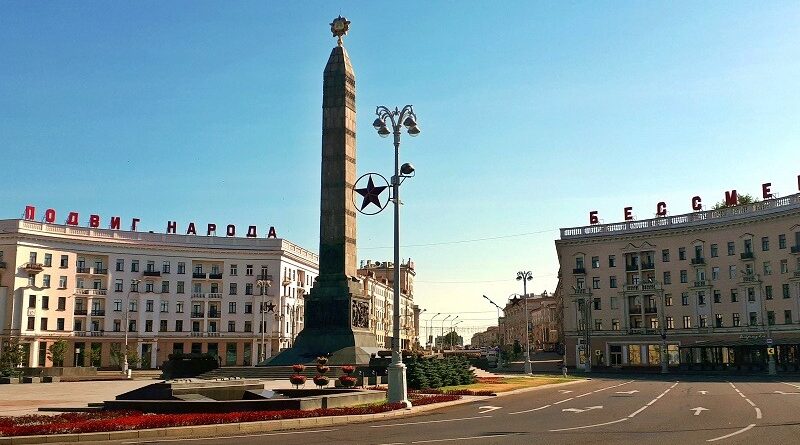Minsk, Belarus: Chasing Soviet Ghosts in Europe’s Last Dictatorship
This travel guide covers my visit to Minsk, the capital of Belarus.
A visit to Minsk
After a night in Istanbul courtesy of the Turkish Airlines free transit hotel programme, and a comfortable connecting flight to Minsk, I had finally arrived in Belarus.
I’ve visited Minsk twice before, each time for a short two-day stay while travelling between Lithuania and Ukraine, as a Belarus transit visa was much easier to obtain than a full visa back then.
However, for the past few years, Belarus has started granting visa-free access to citizens of most European countries, which I was also making use of on this trip (which took place in 2019, for the record).
For what it’s worth, while I’ve always found Belarus a safe country to visit, I wouldn’t recommend travelling there now — something that especially applies to Western travellers due to the high risk of politically motivated arbitrary arrests.
Needless to say, the invasion of Ukraine by Russia — the closest ally of Belarus — has significantly complicated matters when it comes to travel, both from a safety and moral perspective, so keep this in mind when you visit Minsk.
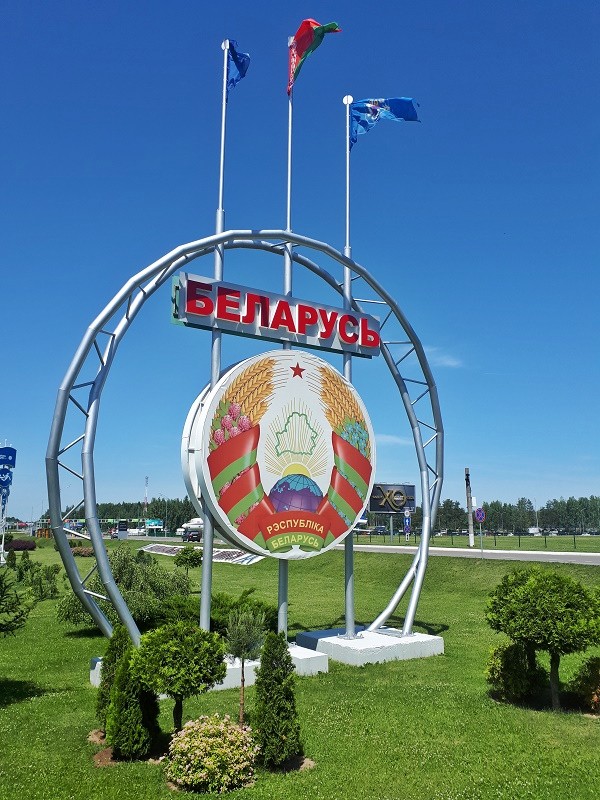
Arrival formalities
Once I walked through the jet bridge into the airport terminal, it was a short walk to passport control, where the queues were relatively short.
There was certainly some tension in the air as I arrived at Belarus passport control, as even during my trip, in relatively peaceful times, the dictatorial country had poor relations with the West and a deplorable human rights record.
Fortunately, I was allowed into Belarus without much issue, as even though the immigration officer had to call in a supervisor for a secondary check, they happily stamped my passport after asking a question or two about the purpose of my trip and my short, one-night stay in the country.
Basically, all you need to show is proof of an onward ticket, a hotel reservation, as well as evidence of sufficient funds and health insurance that covers Belarus (if you don’t have this, you can typically purchase a short-term plan on arrival from one of the booths of Belarusian health insurers).
After withdrawing some Belarusian roubles from an ATM in the arrivals hall, I ventured outside the terminal to catch one of the frequent airport buses to the city centre of Minsk, which is about an hour away.
From the bus window, I saw the first of many Soviet monuments that I would encounter during my stay in Minsk, situated right next to a motorway interchange between the airport and city centre.
This monument is the Mound of Glory, a World War II memorial hill topped with four rising bayonets, built in honour of the liberation of Belarus during Operation Bagration in 1944 and the final victory over Nazi Germany in 1945.
In Belarus, as in the other countries that made up the former Soviet Union, World War II is widely known as the Great Patriotic War.
With the exception of Poland and Ukraine, few other European countries have experienced such a level of destruction and proportionally high casualty rates during World War II as Belarus, and the scars of the war remain visible.
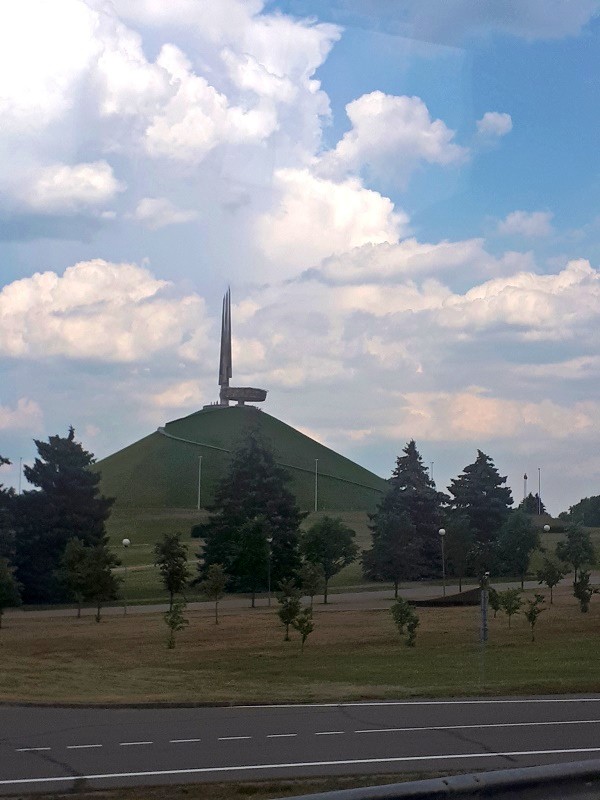
Into the metro
The airport bus goes directly to a bus terminal located right next to Minsk’s main train station, stopping halfway at the Uručča metro station on the north-eastern outskirts of the city.
I decided to get off the bus at Uručča and connect to the metro there, thinking it would likely be quicker than getting stuck in traffic in the city centre.
From Uručča, I took the metro on the blue line for a couple of stops until I reached Ploshchad Lenina (Lenin Square), where I emerged once again above ground.
Upon disembarking at the metro station, the surroundings at Lenin Square already felt distinctly Soviet.
The dark clouds approaching the city on this balmy day in mid-June certainly played a role in creating a gloomy, communist atmosphere.
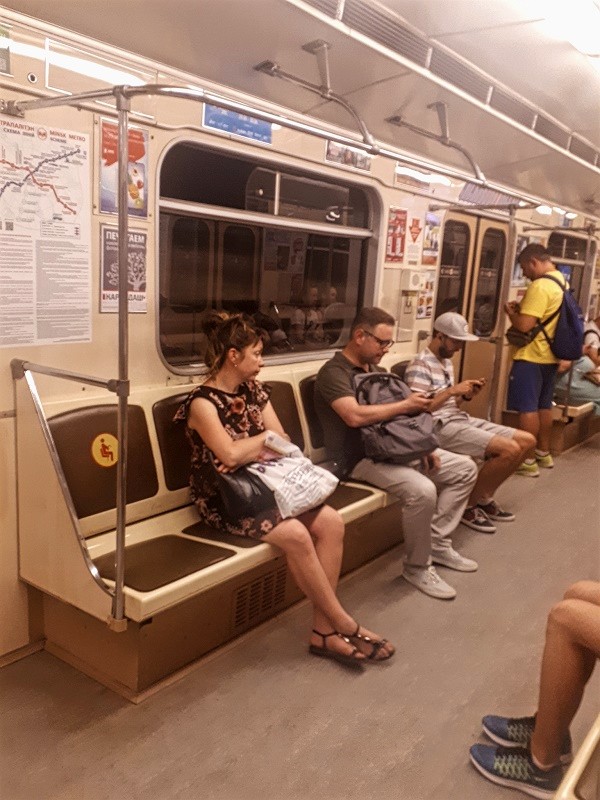
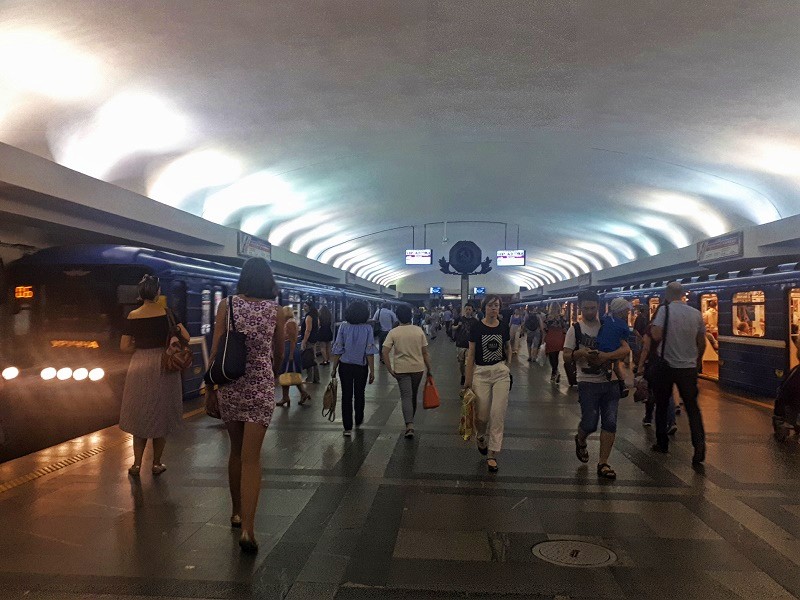
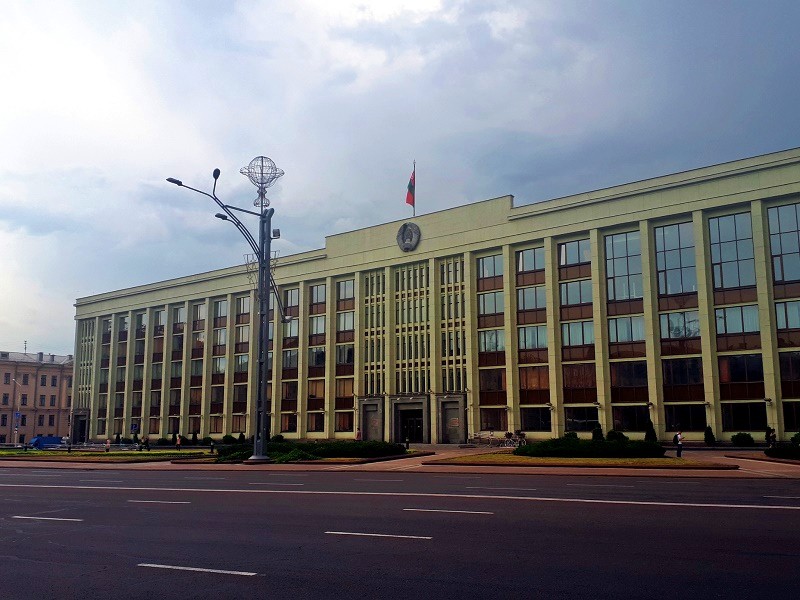
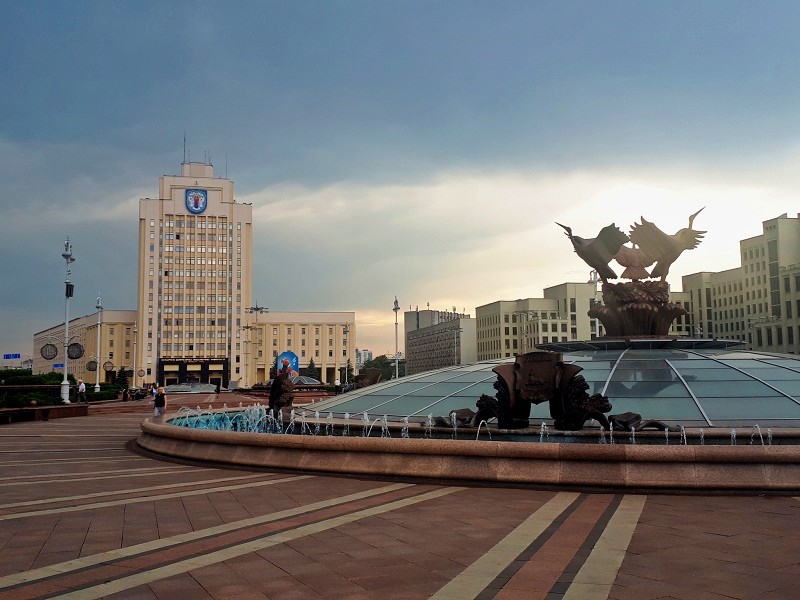
Hotel Minsk
For my one-night stay in the Belarusian capital, I had chosen Hotel Minsk, one of the larger and more affordable communist-era hotels in the city.
I paid the equivalent of 60 US dollars for my small single room.
The communist-era legacy of the hotel still shows in the design and décor of the lobby, rooms, and stuffy corridors, even though it has undergone some renovation since the collapse of the Soviet Union and offers all the modern amenities you might need.
As it was still mid-afternoon and I had plenty of daylight left to explore Minsk, I quickly dropped my luggage in the room and set out for a walk through the city centre.
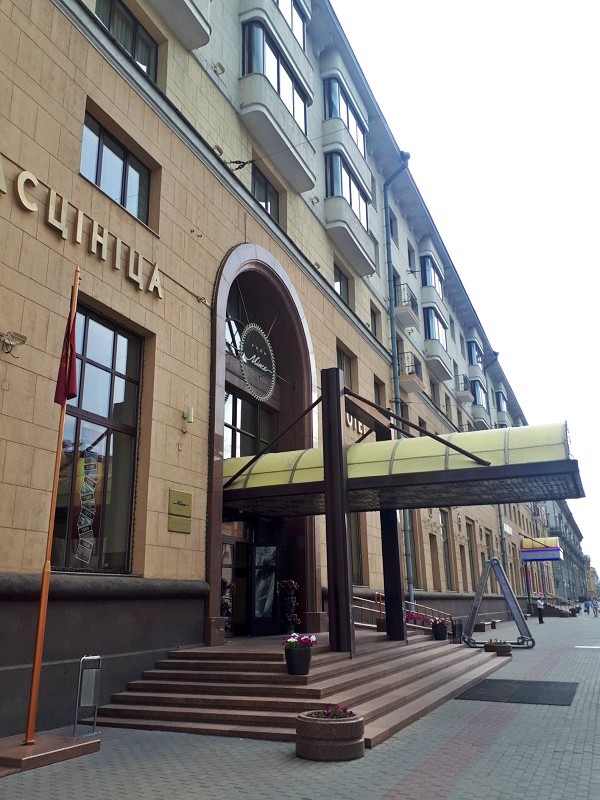
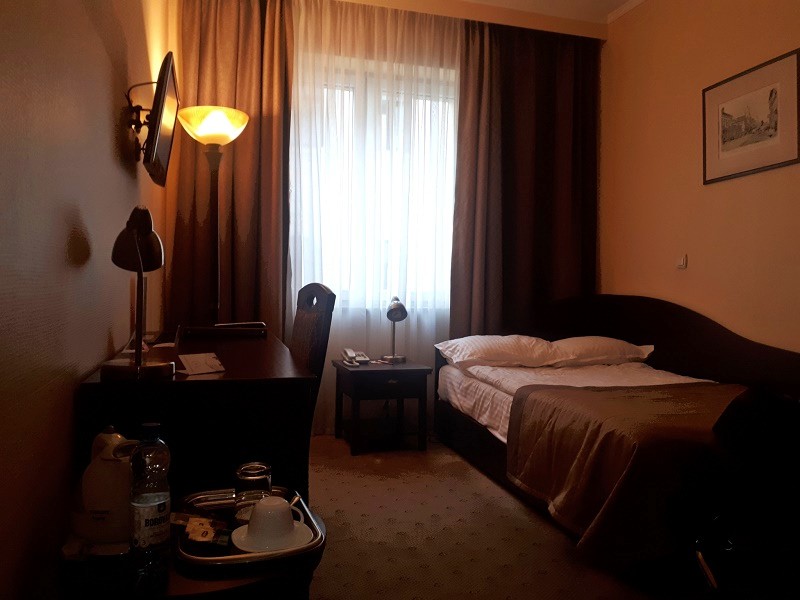
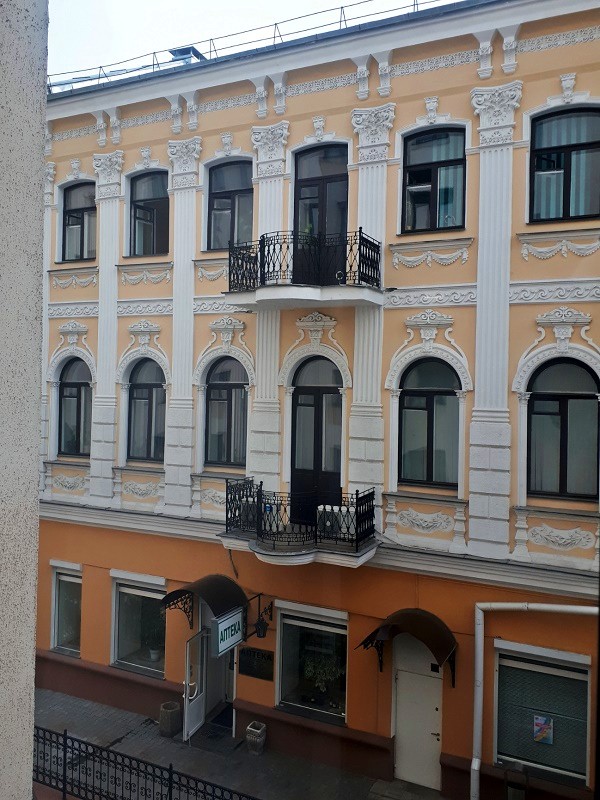
Soviet architecture
I started my tour of the city back at Lenin Square, where in addition to a large Lenin statue and numerous communist buildings like city government offices and the main building of Minsk State University, you can also find the lovely red-brick Saint Simon and Saint Helena Church, which dates back to 1910.
This Roman Catholic church is one of the few old buildings in Minsk that survived the devastation of World War II.
After the city’s destruction in World War II, Minsk was rebuilt in typical Soviet style.
Especially when walking along Prospekt Nezavisimosti (Independence Avenue), the central axis of Minsk, you can admire grand Soviet-era architecture, with many buildings designed in the Stalinist style, an architectural style also known as socialist classicism, which was popular in the Soviet Union from the 1930s to the early 1950s.
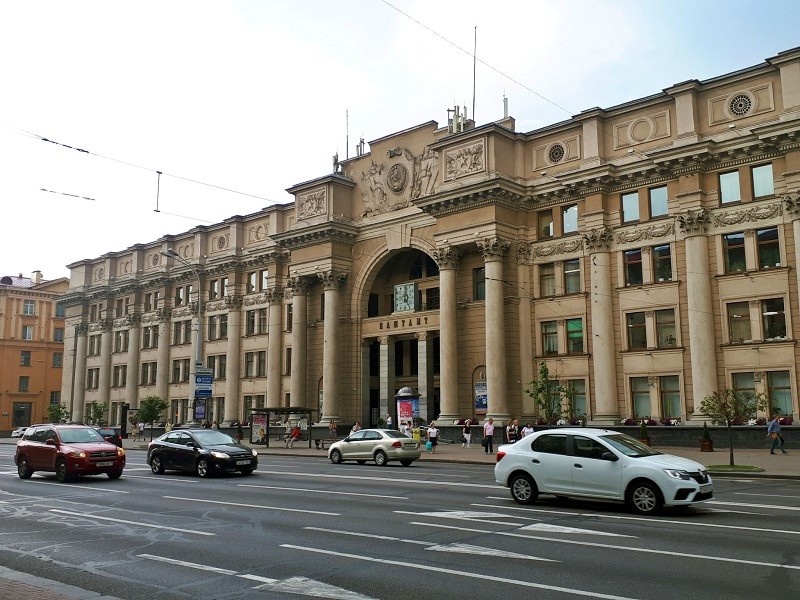
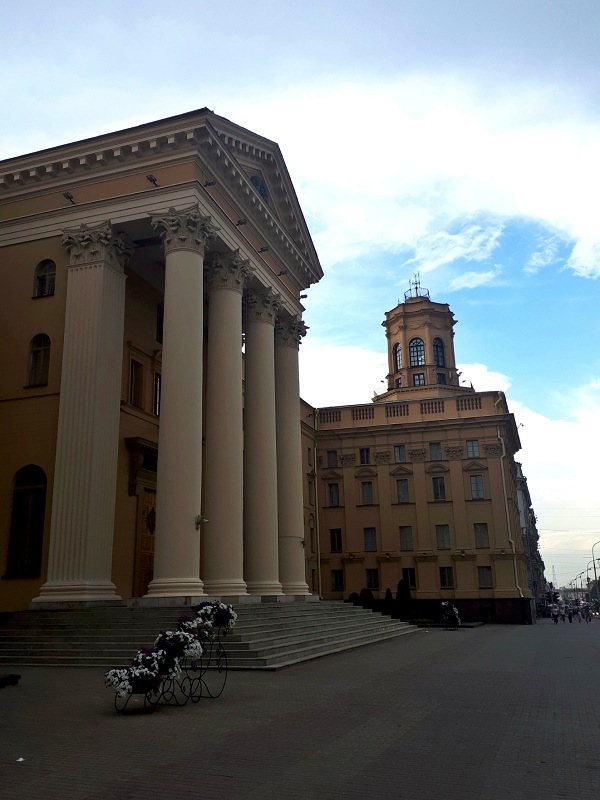
Soviet ghosts
It was my third time in Minsk, and one aspect of the city that I’ve always found intriguing as a foreign traveller is how alive the Soviet history and legacy are.
While in many other countries that were part of the Soviet Union, communist traces have been removed from the streetscape and government institutions have westernised and democratised, Belarus seems to embrace its past, and this is clearly visible in Minsk.
One of the most impressive socialist classicist buildings on the main avenue in Minsk belongs to the Belarusian State Security Committee, a secret police and intelligence agency better known by its acronym KGB (Komitet Gosudarstvennoy Bezopasnosti).
Opposite the building, you can even find a statue of Felix Dzerzhinsky, the infamous Bolshevik who led the Cheka, the predecessor of the KGB under Lenin.
The fact that the KGB still operates in Belarus and that notorious figures like Dzerzhinsky still have such a prominent place in the streetscape of Minsk speaks volumes about how unfree and undemocratic the country is.
As a foreign tourist, you may not immediately notice this, as life in Minsk initially appears much like that of any other European city, with people heading to work, meeting friends, and spending time in cafés and restaurants.
Indeed, on my first visit to Minsk, I was surprised to see a group of young people drinking alcohol and playing loud music from a stereo in public, right in front of the Dzerzhinsky statue.
These are the great contradictions of Belarus, where people are free to move around and enjoy modern life, yet must adhere to strict limits on their behaviour and expression unless they are willing to risk trouble with the authorities.
There are no free elections, protests are violently suppressed by riot police, criticism of the authorities and dissent are met with reprisals, and even displaying the historic white-red-white Belarusian flag will likely land you in jail.
You could say that on one hand Belarus has a capitalist consumer society, while at the same time it remains a highly repressive dictatorship with no freedom of speech or association.
The old Soviet ghosts are still haunting Minsk even in the 21st century.
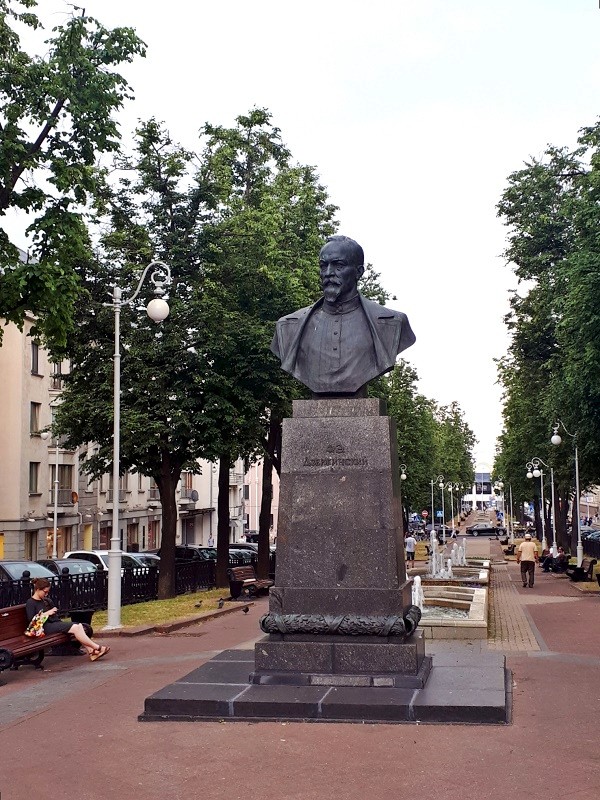
Previous travels to Belarus
I was reminded of my first trip to Minsk as a young student in 2008, when I passed through Belarus during my summer travels, which also included Lithuania, Ukraine, Moldova, and Romania.
On the Vilnius-Minsk train, I met a Lithuanian-Belarusian girl who was kind enough to show me the way from the railway station to my hotel upon arrival.
She told me that many hotel rooms are still bugged by the KGB, with the state security services actively listening in on people — a practice that was common in Soviet times but has never truly disappeared in Belarus.
Although Belarusian citizens are free to go where they want, all their movements are still being watched and recorded, according to her.
Given that she had dual citizenship and lived in Lithuania, she wasn’t afraid to speak out against the Belarusian regime but mentioned that others might be afraid to do so in public, as they could always become targets of reprisals.
Indeed, on that trip, it seemed almost impossible to talk to anyone else, as locals appeared highly suspicious of outsiders and barely spoke a word of English, with my lack of Belarusian and Russian language skills not helping either.
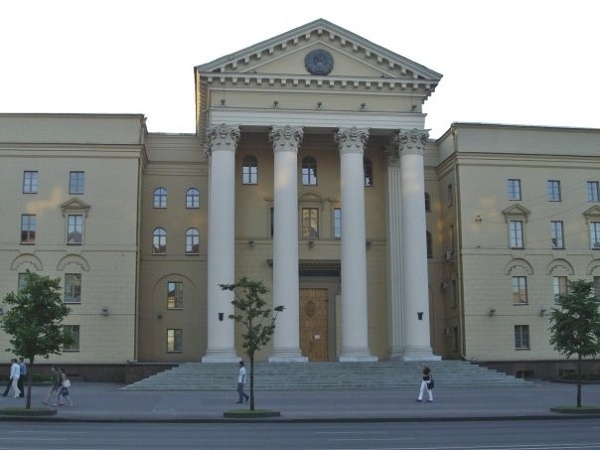
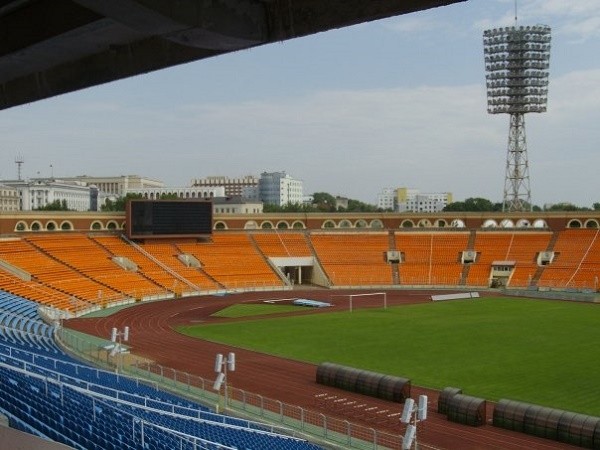
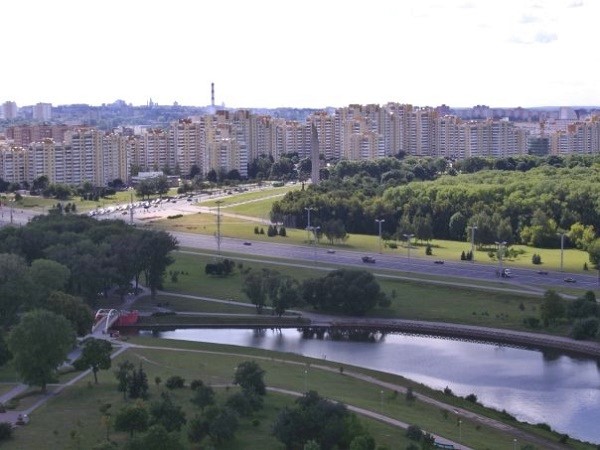
Second Belarus visit
On my second visit to Belarus in the winter of 2012, the country seemed completely different.
Even on those cold winter days, the locals appeared more open, English was more widely spoken, and the city seemed much more modernised.
Some Belarusians I had befriended on previous travels around Europe — and was now meeting in Minsk on this trip — told me they were becoming a bit more optimistic about life in the country, despite still having many reservations about the political regime.
Fast forward to this current trip to Minsk in 2019, and I could once again see the country had transformed in a positive direction, despite the obvious shortcomings in democracy.
As part of some currency reforms, a new Belarusian rouble was introduced at a rate of 1 new rouble to 10,000 old ones, so for the first time, withdrawing money meant the bills could actually fit in my wallet and I didn’t have to walk around with large bundles of banknotes.
Metro signs were suddenly bilingual, with an English translation beneath the Cyrillic script, everyone I bumped into on the streets and in bars was eager to talk and spoke fluent English, and once again, the city of Minsk appeared much more modern and affluent than on my previous two trips.
Of course, all hopes for a better future turned out to be short-lived, as a year after my trip, the 2020 Belarusian elections saw widespread fraud by incumbent President Alexander Lukashenko to secure another term.
Opposition leader Sviatlana Tsikhanouskaya claimed that victory was stolen from her by Lukashenko, and widespread protests followed in Minsk and other cities across Belarus, with locals equally struggling to believe that Lukashenko had defeated his opponent by 81.04% to 10.23%.
Despite hundreds of thousands of people taking to the streets of Minsk and other Belarusian cities, the protests were violently crushed by the authorities, and opposition leaders were either arrested or forced to flee abroad, including Tsikhanouskaya, who formed a government in exile.
Many of those arrested faced torture in prisons and sham trials in Belarusian courts as the Lukashenko regime swiftly reverted to using Soviet-era repression tactics, which had been unheard of even in the decade before, when the country wasn’t exactly a beacon of political freedom either.
Since the start of the Russian invasion of Ukraine, Belarus has slipped even further into a state of brutal repression and authoritarianism, becoming increasingly intertwined with Russia and drifting further away from the free world.
Unsurprisingly, many of my Belarusian friends have since fled the country in search of a better life in Europe and the Americas.
It’s sad to see that decades of slow progress have been completely undone, with Belarus now drifting in the opposite direction of where it was once heading, fully steaming back towards Stalinism under the authoritarian rule of Lukashenko who coincidentally also sports a large moustache like Stalin.
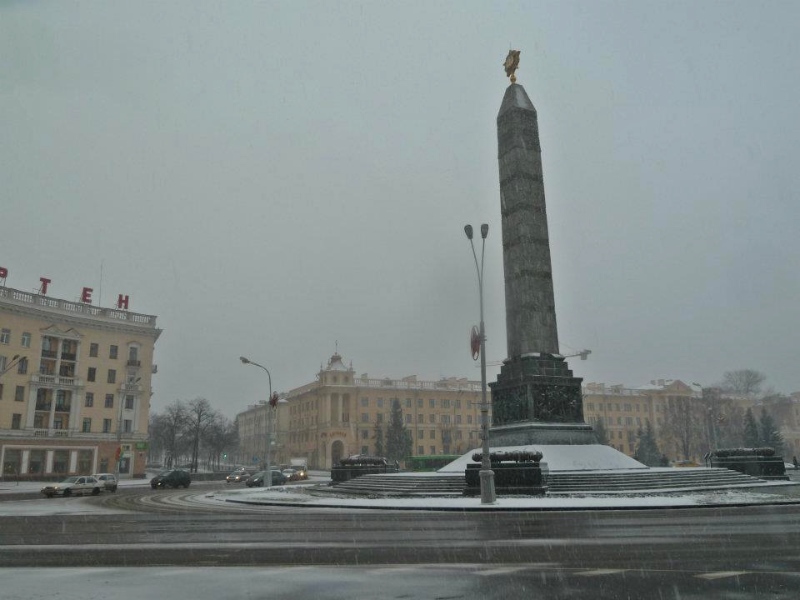
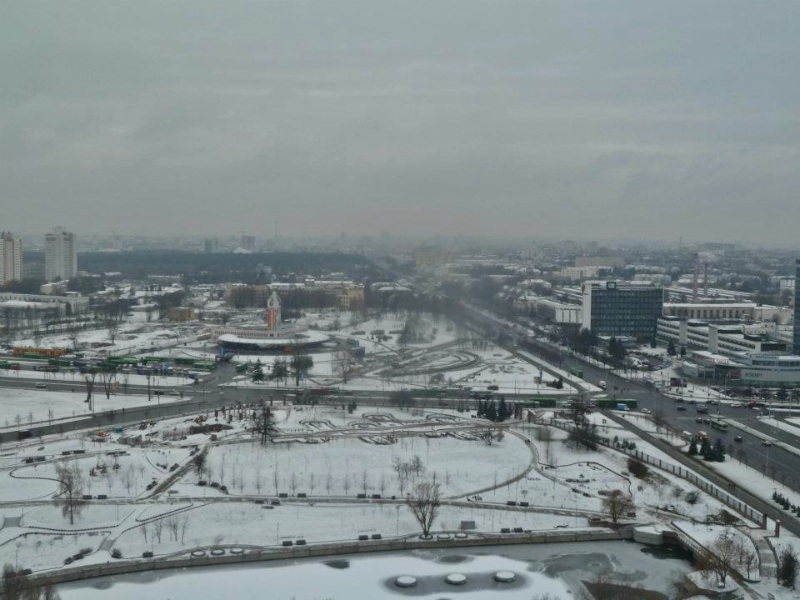
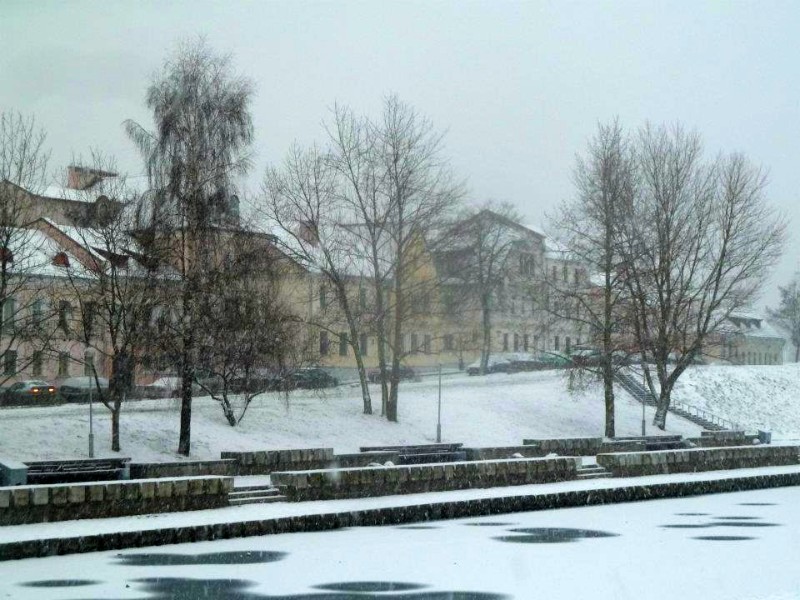
Communist glory
When visiting Minsk or writing about travel to Belarus, it’s hard to avoid discussions about political repression in the country, and although there is much more to be said on the topic, let’s return to my actual trip and continue my tour around the sights of the city.
As I continued my walk down Prospekt Nezavisimosti, I arrived at Kastrychnitskaya Square, where even more communist glory can be found.
Kastrychnitskaya metro station, with its huge pillars resembling lamp posts, large stone reliefs of the communist hammer and sickle, and a stunning Soviet mural at one of the station’s entrances inside a building lining the main avenue, is one of the most remarkable in all of Minsk.
On Kastrychnitskaya Square, you can also find the Palace of the Republic, a large venue used for state functions, forums, conventions, and concerts.
It’s an unusual building, as it clearly has a Soviet design (with construction having started in 1985), but since it was only completed in 2001 after years of interrupted construction following the breakup of the Soviet Union, it also features some modern touches.
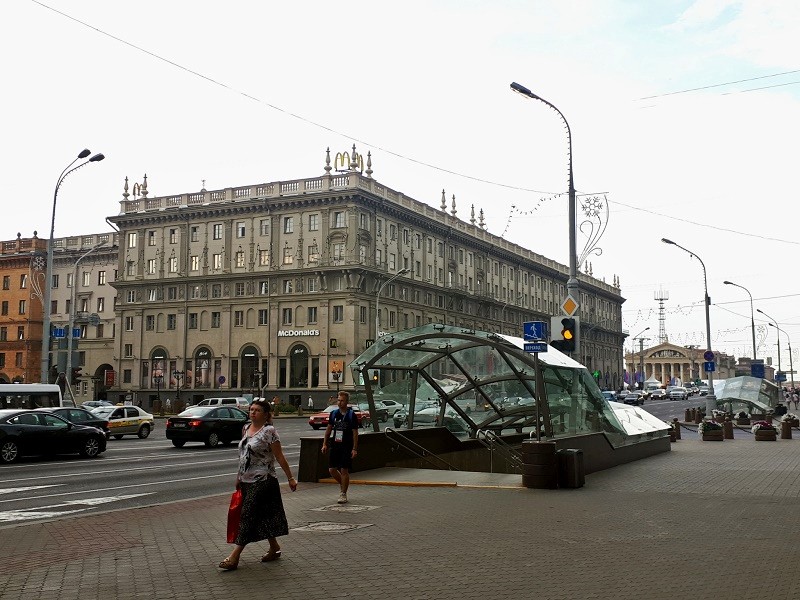
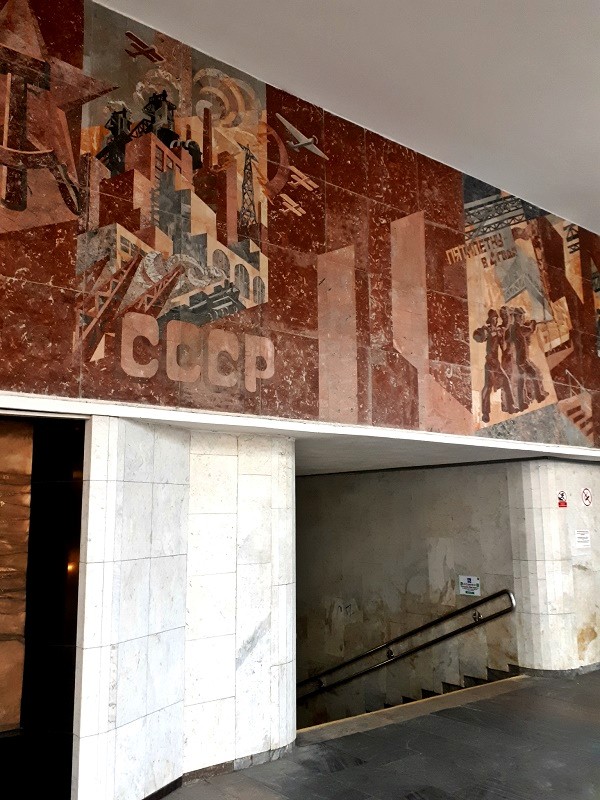
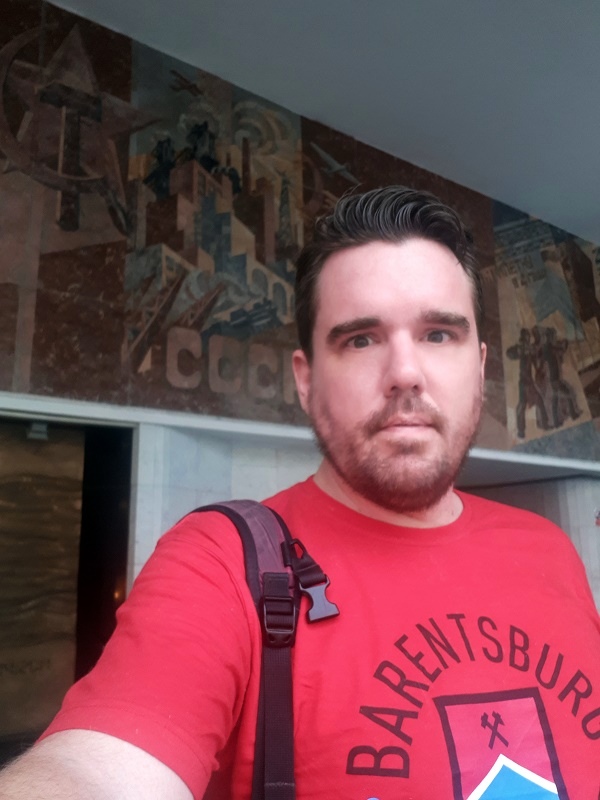
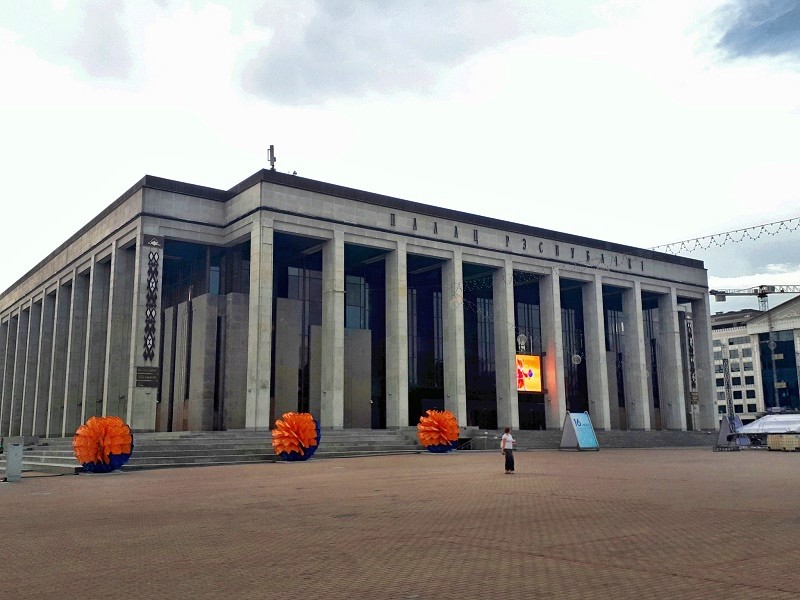
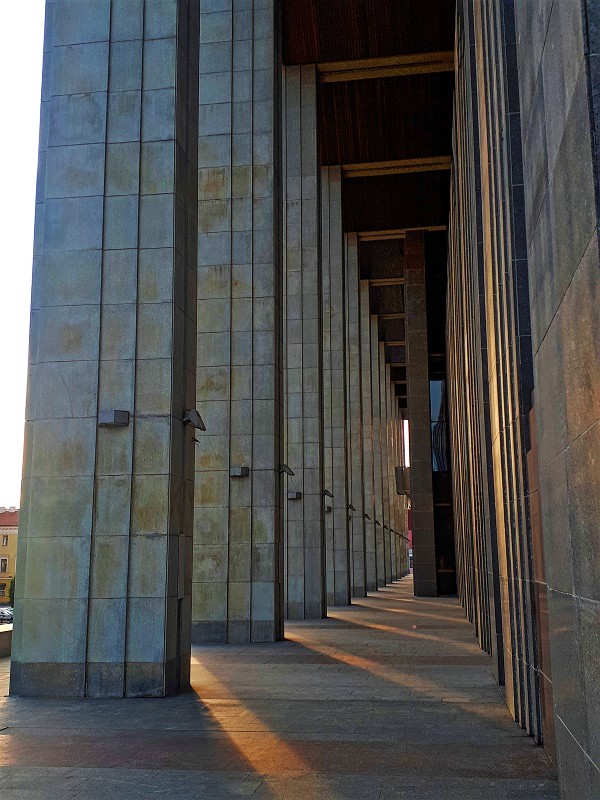
Minsk old town
At Kastrychnitskaya Square, I turned left off Prospekt Nezavisimosti and walked towards the old town of Minsk.
As you walk in this direction, the grand Soviet buildings gradually give way to older architecture.
Just before reaching the old town, I passed by the Minsk City Hall, where you can find the sculpture “Voyt” — a statue of an old mayor of Minsk holding the city keys and a royal charter, created to honour Minsk receiving town privileges under the Magdeburg Rights in 1499.
A block behind the city hall lies the heart of the old town of Minsk.
The old town of Minsk isn’t large, as almost all of it was destroyed in the Second World War and very little has been rebuilt in its original style, but the area still makes for a pleasant visit.
In the old town of Minsk, you can admire a couple of beautiful churches and stroll around streets lined with cafes, bars, restaurants, and night clubs in a small pedestrian zone.
The whitewashed Holy Spirit Cathedral, with its twin towers, was built between 1633 and 1642 and serves as the mother church of the Belarusian Orthodox Church.
Adjacent to the cathedral, on the same square, lies the Roman Catholic Church of Saint Joseph, built in 1752, with its fine baroque façade.
However, much to the dismay of the local Catholic population, the church is being used to store state archives, serving as a reminder that strongmen like Lukashenko and Putin are no champions of religious liberty, despite the mistaken belief held by large parts of the American Christian and nationalist right that such freedoms are better preserved in countries like Belarus and Russia than in the US.
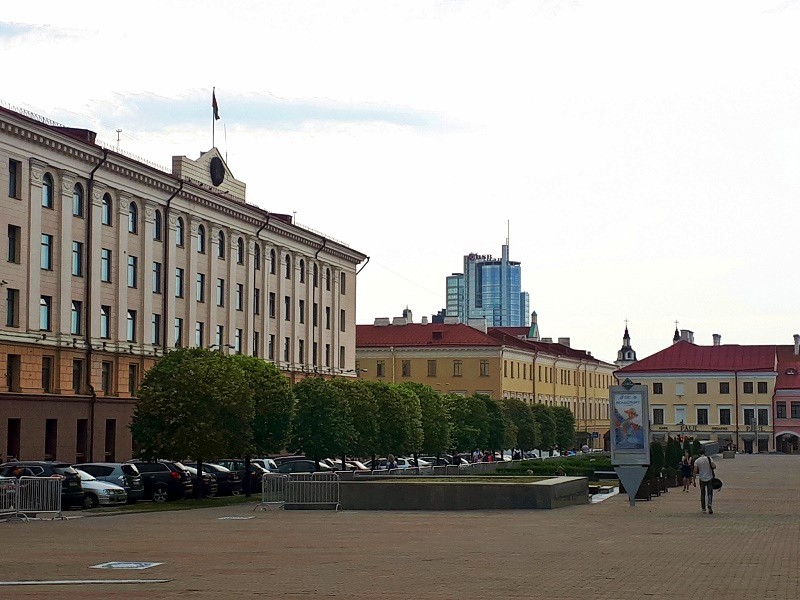
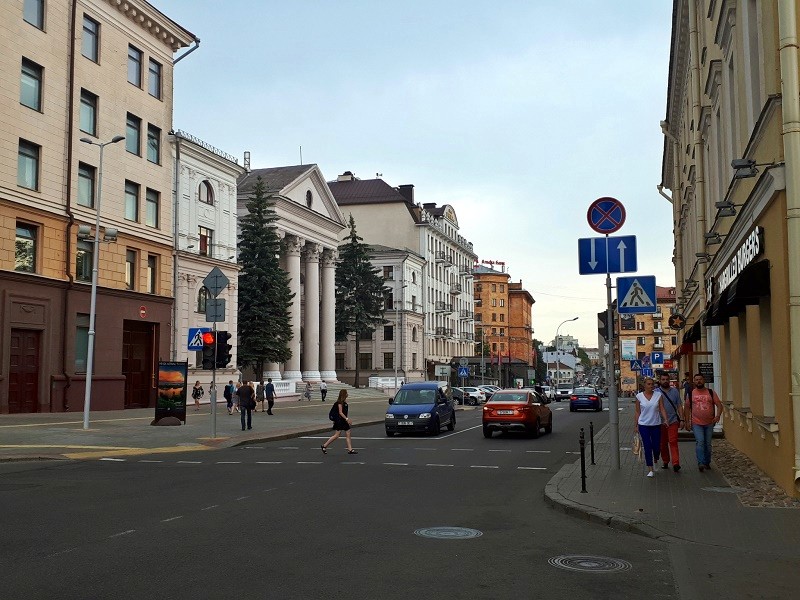
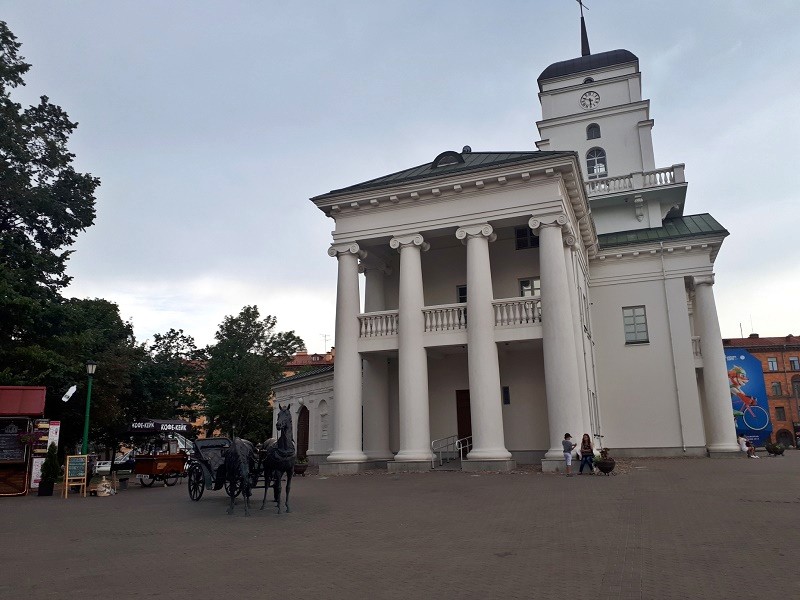
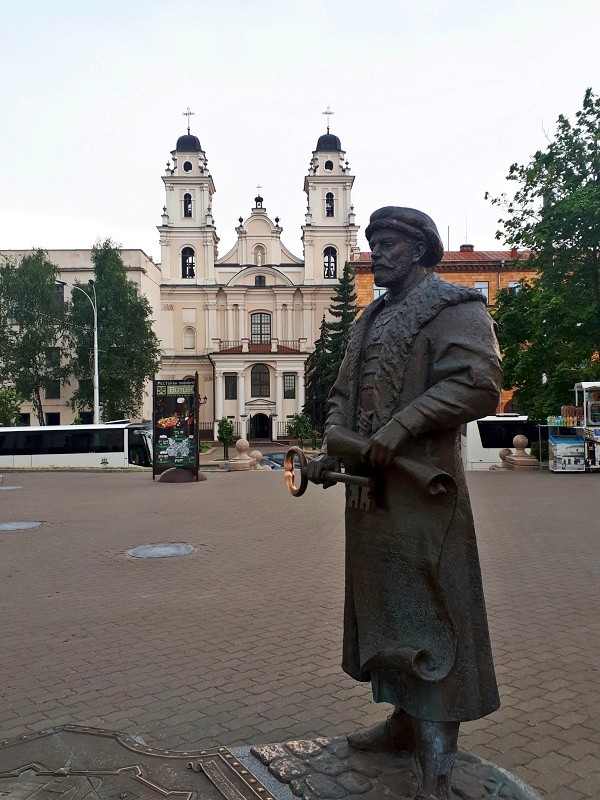
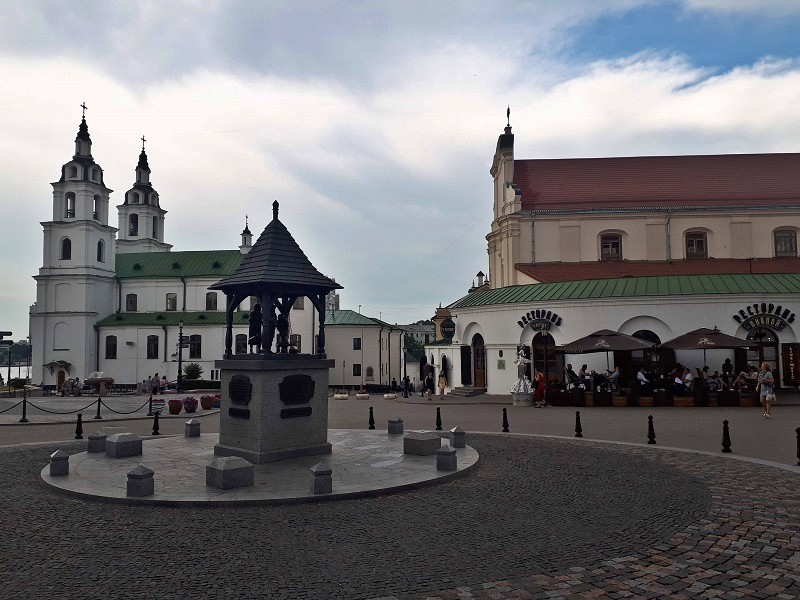
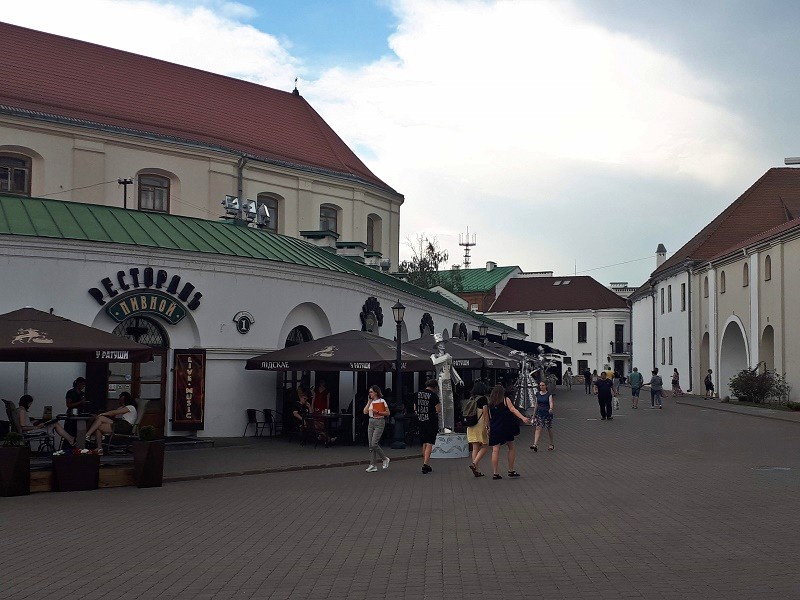
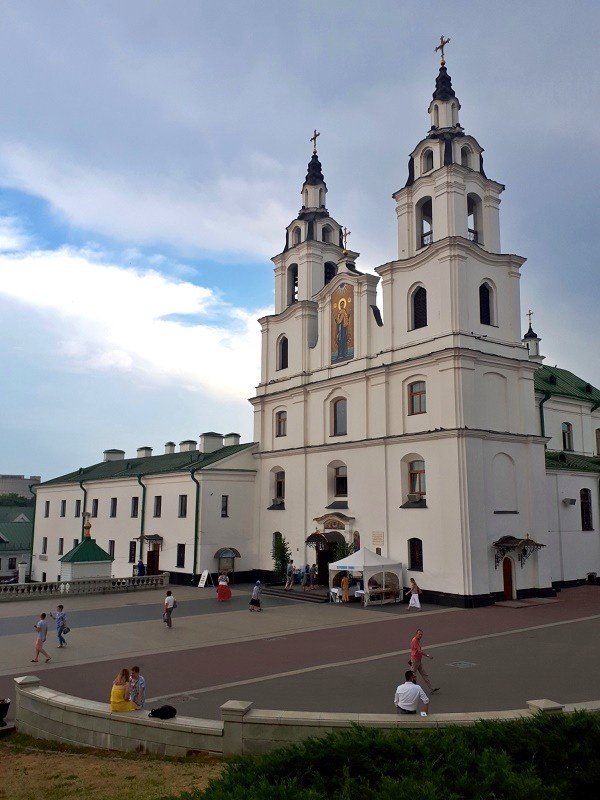
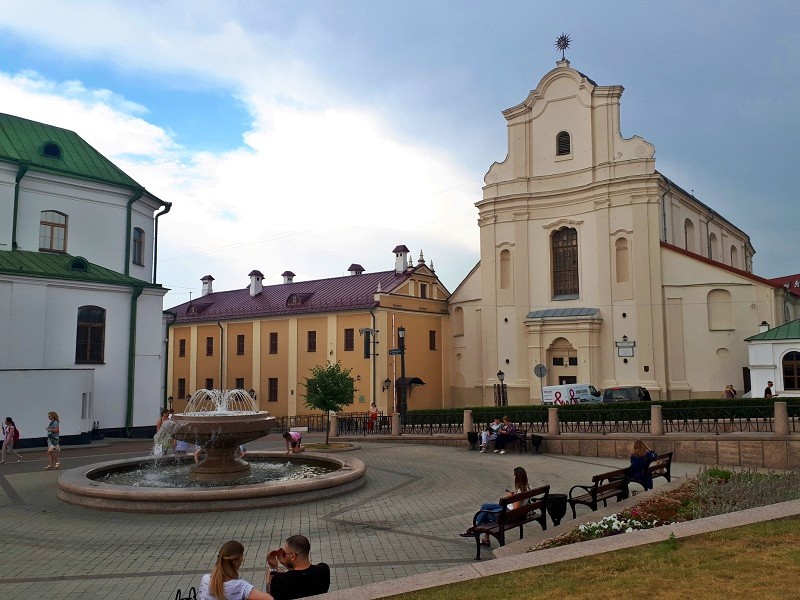
Soviet KFC
Even though some parts of the old town of Minsk faintly resemble cities in eastern Poland or Lithuania, Soviet architecture and ugly communist-era apartment blocks are never far away.
Indeed, even when standing on the attractive hilltop square in front of the Holy Spirit Cathedral, you find yourself looking out over typical Soviet blocks of flats lining both sides of the Svislach River, which bisects Minsk.
Yet even these Soviet remnants can possess a certain beauty despite their ugliness.
A certain beauty can definitely be found in the brutalist Soviet relief on a building opposite the entrance of Nyamiha metro station, which now houses a KFC branch.
Move over Colonel Sanders: It’s time for Soviet-style KFC from Comrade Sanders!
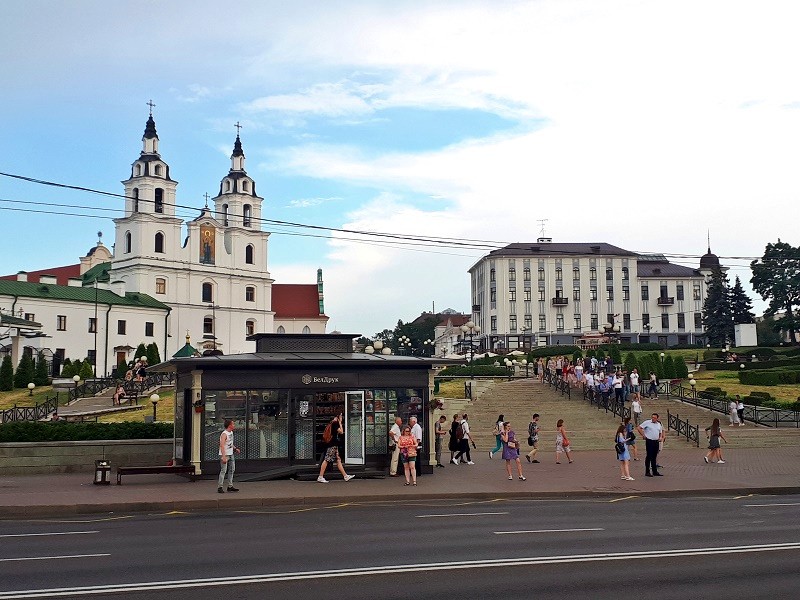
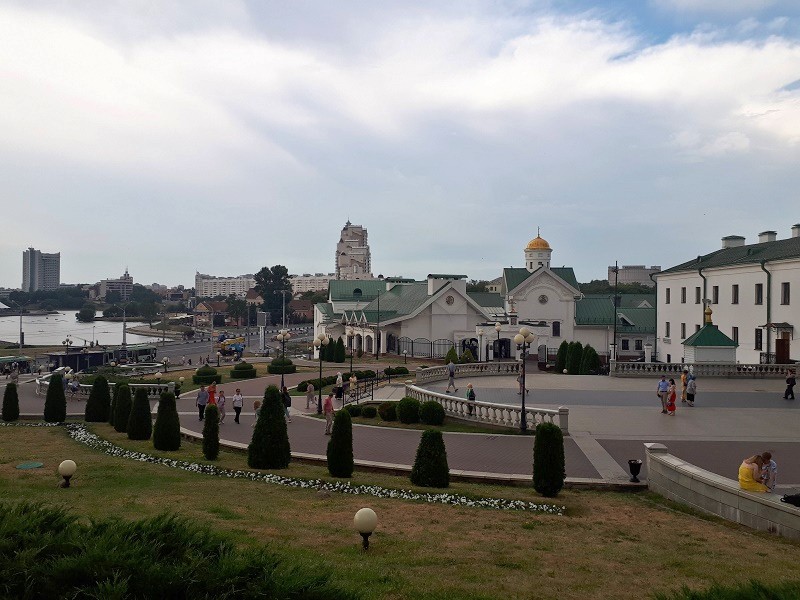
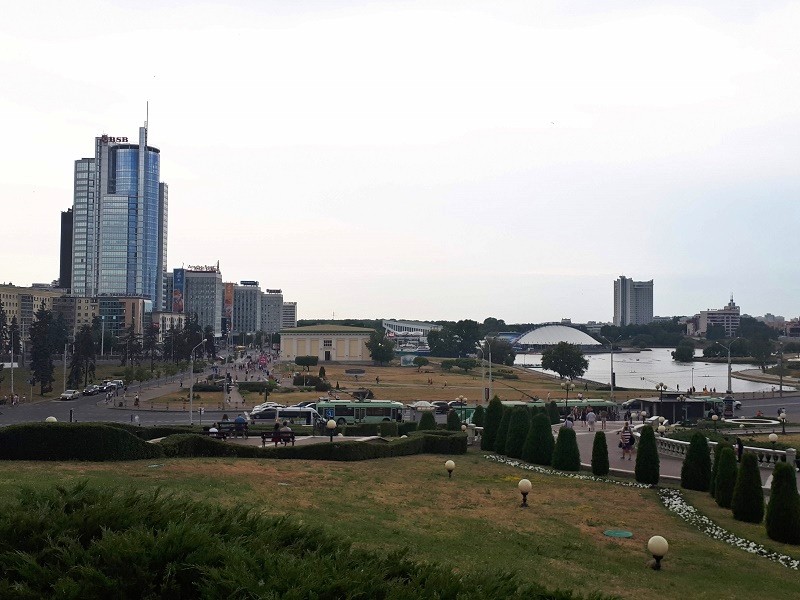
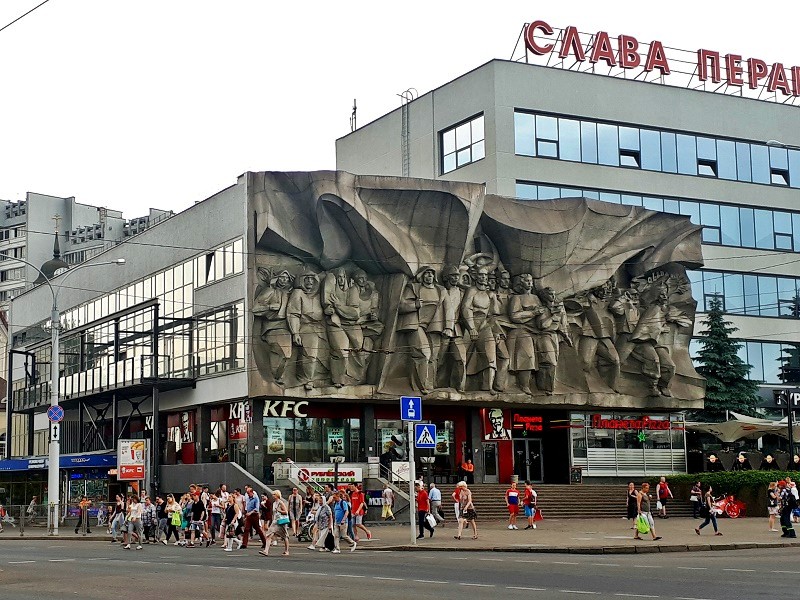
Svislach River and the Island of Tears
Immediately north of the old town, a pleasant park stretches along both shores of the Svislach River, which is so wide that it almost feels more like a lake than a river.
On the eastern bank of the river, you can find the old Trinity Hill neighbourhood and some big Soviet apartment blocks, while on the other side some modern office blocks dominate the scenery.
There is a small island in the middle of the Svislach River, accessible via a bridge from the eastern shore, called the ‘Island of Tears’.
This island features a monument commemorating the Belarusian soldiers who fell in the Soviet-Afghan War.
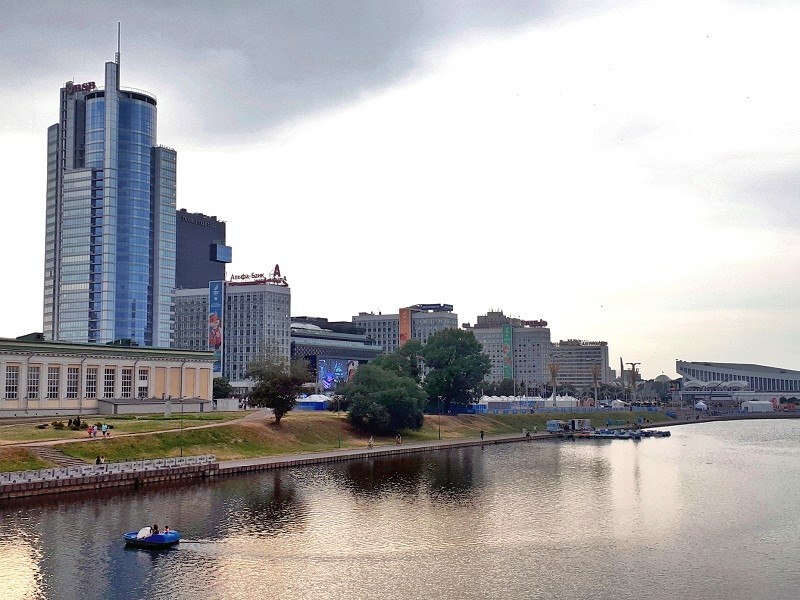
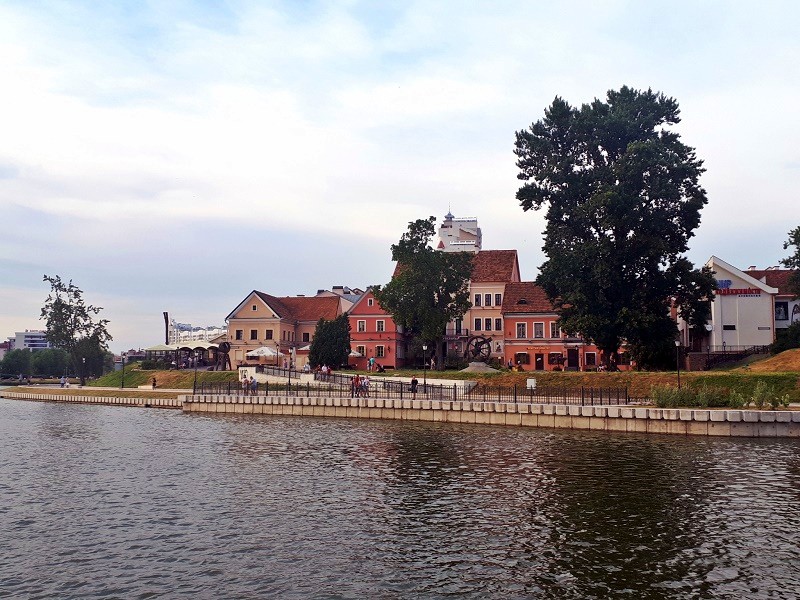
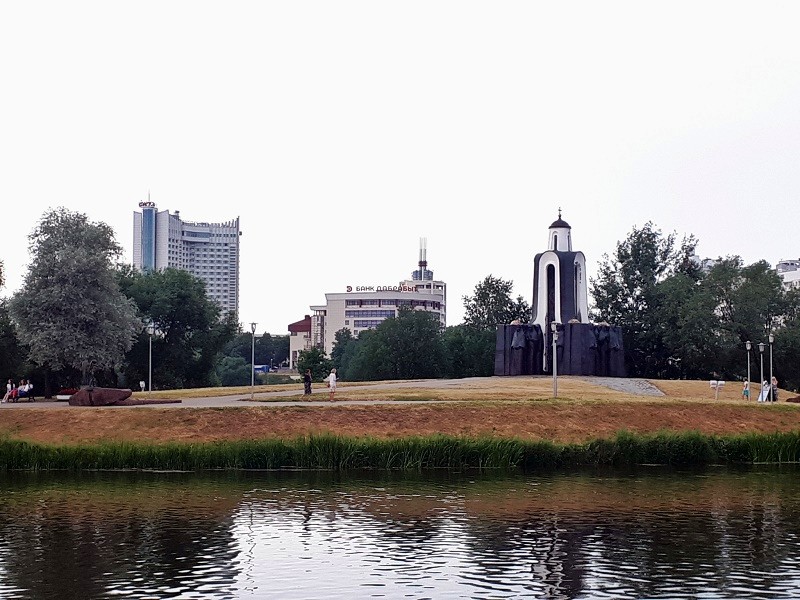
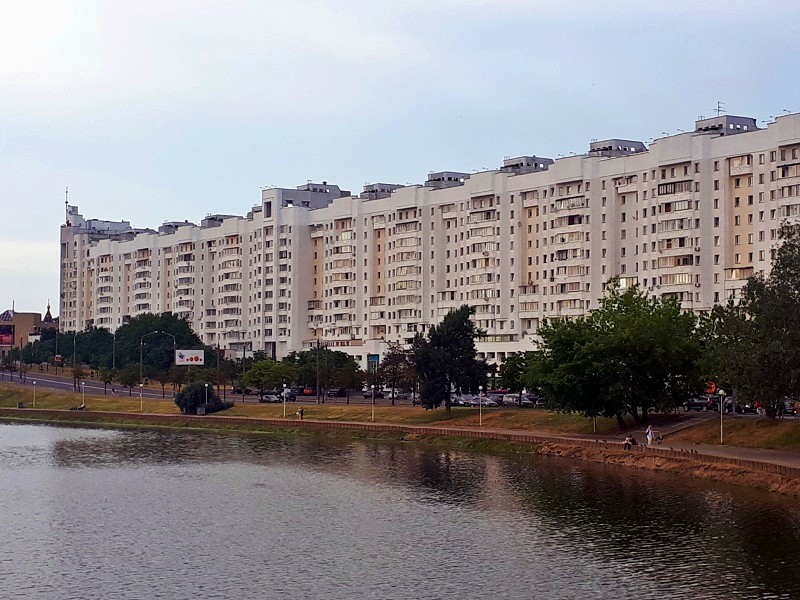
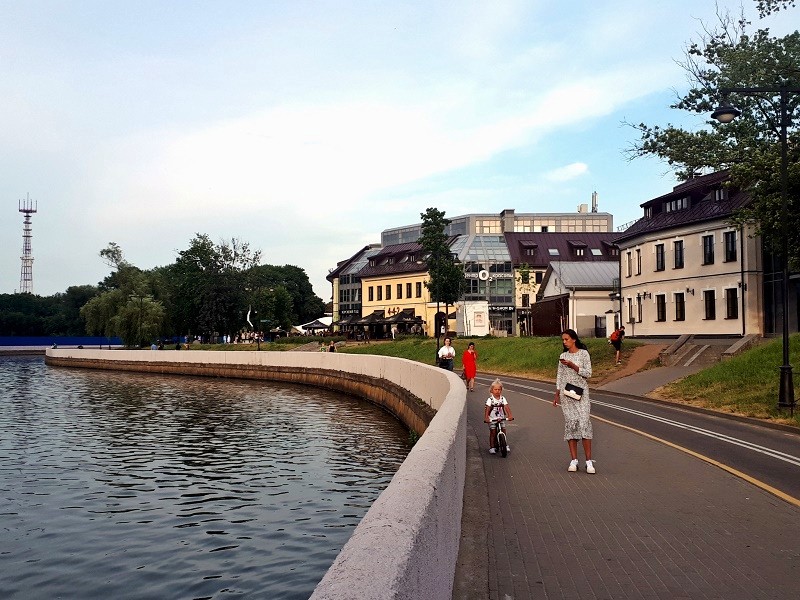
Trinity Hill
After a short walk along the shores of the Svislach River, I entered the small Trinity Hill neighbourhood, the oldest surviving area of Minsk.
Here, I stopped at an appealing looking restaurant with outdoor seating, where I sat down for a light dinner.
I ordered the most traditional dish in Belarus, a plate of draniki (potato pancakes), which in my case were filled with meat.
The potato pancakes and the local beers I ordered certainly tasted good!
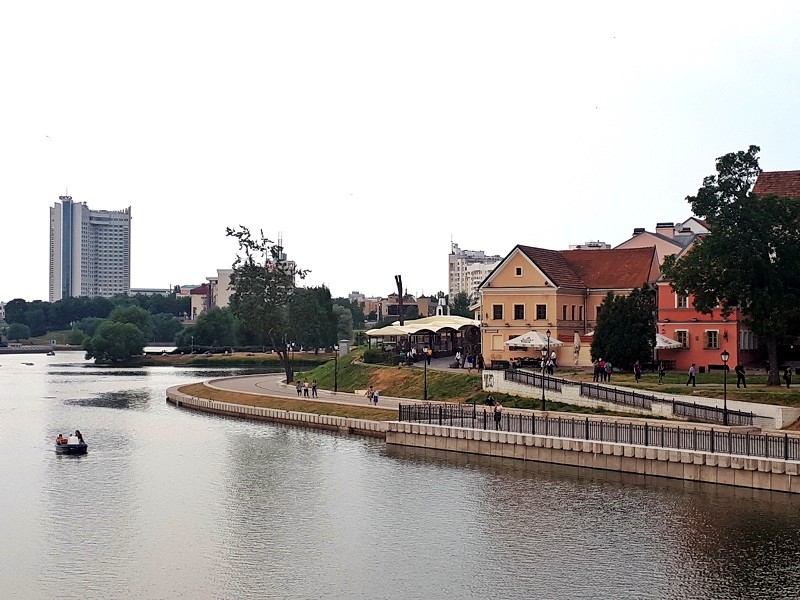
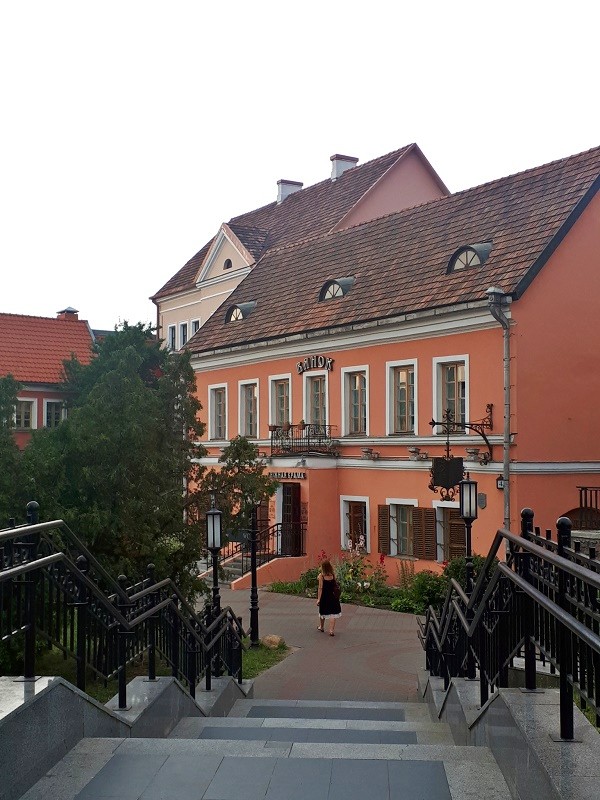
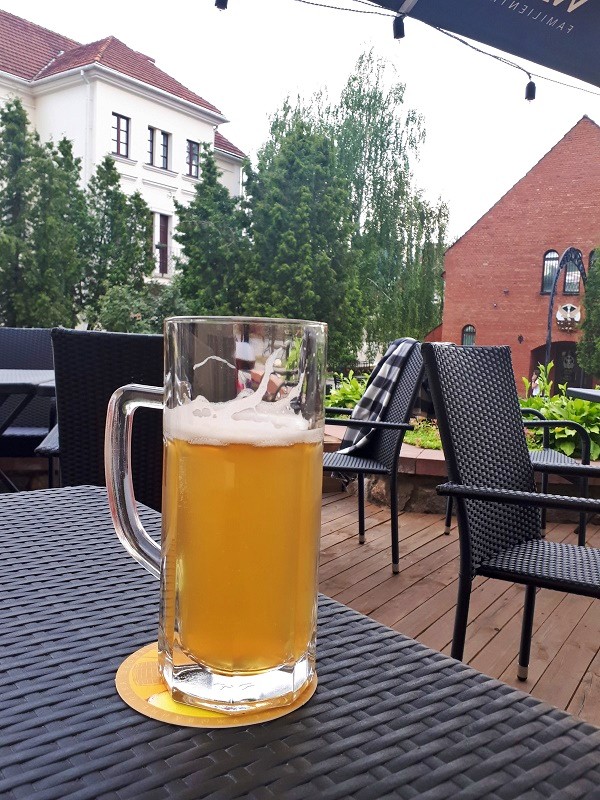
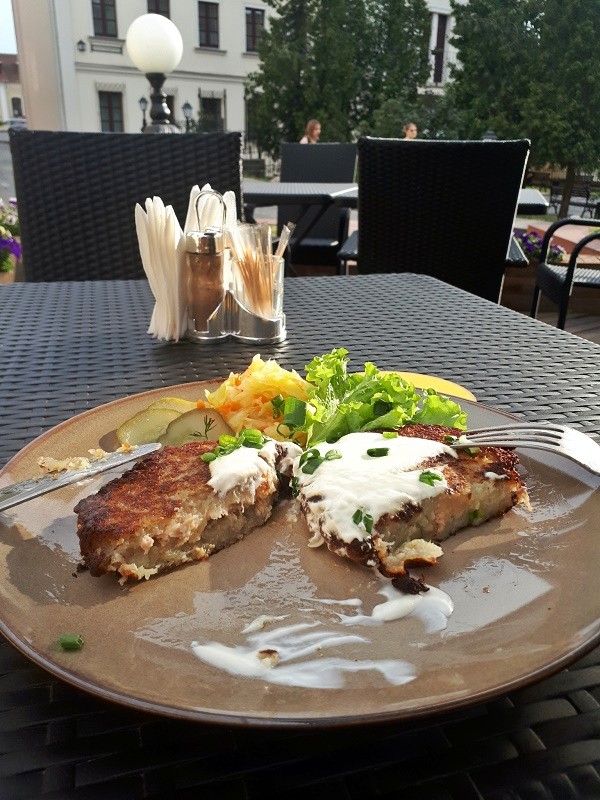
Beer time
From Trinity Hill, I crossed back over to the other shore of the Svislach River into the old town, which by around 7 in the evening had become quite lively, there being plenty of locals enjoying a stroll through the area.
By chance, I walked by a great craft beer place called BeerCap, which had a fun outdoor bar with a couple of local and international craft beers on draught and a fun-loving vibe.
Naturally, I had to stop for a pint or two, and both of the local IPAs I sampled were excellent.
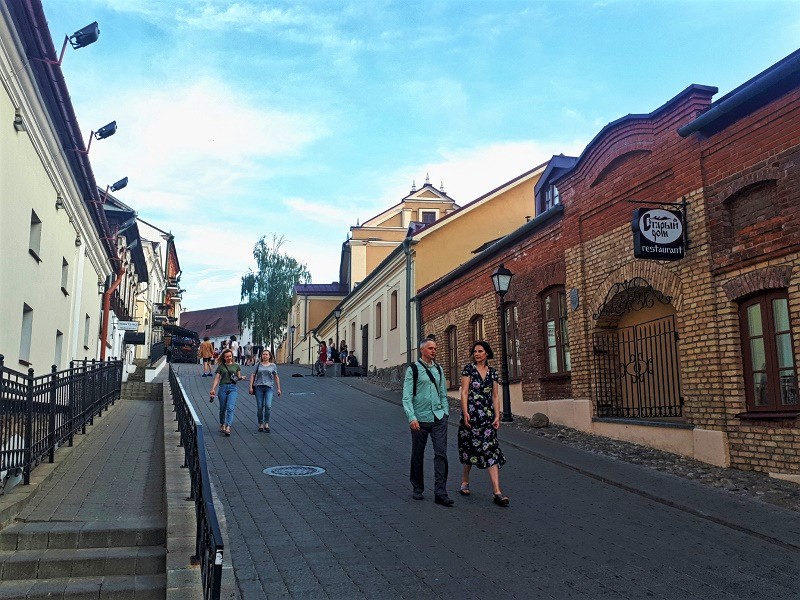
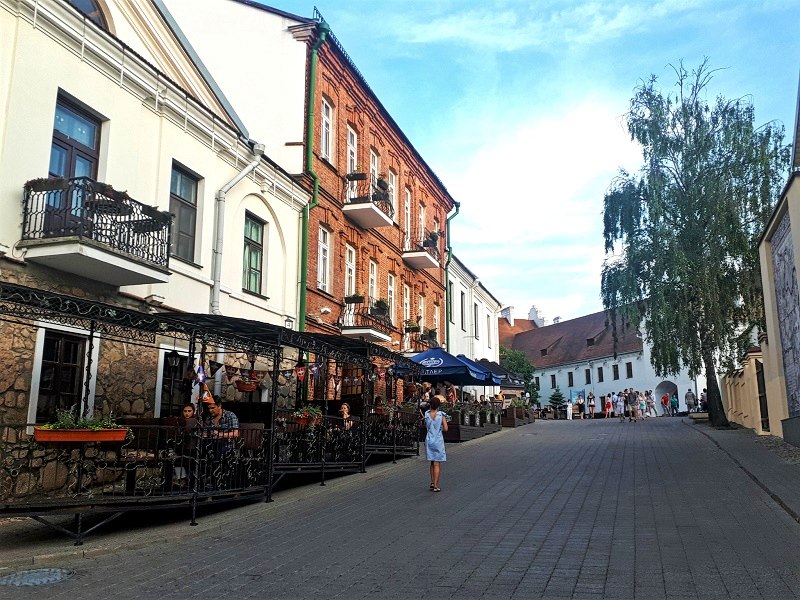
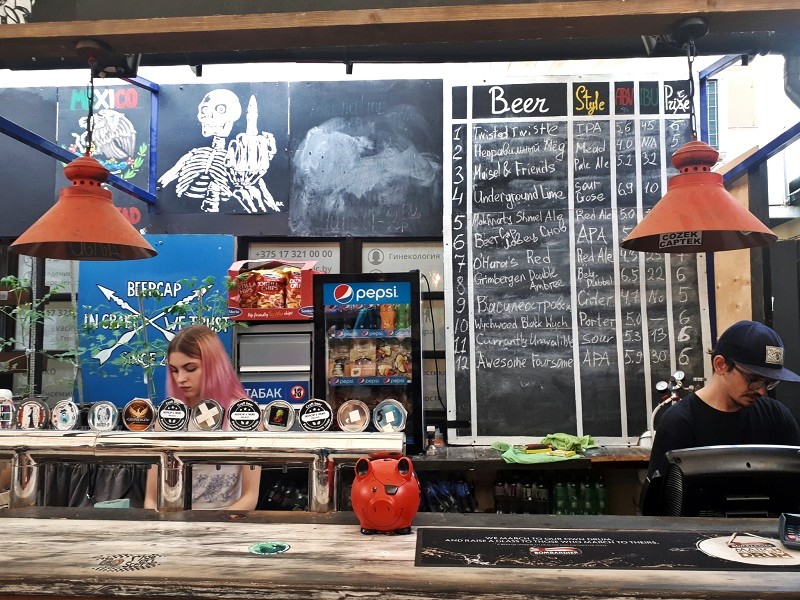
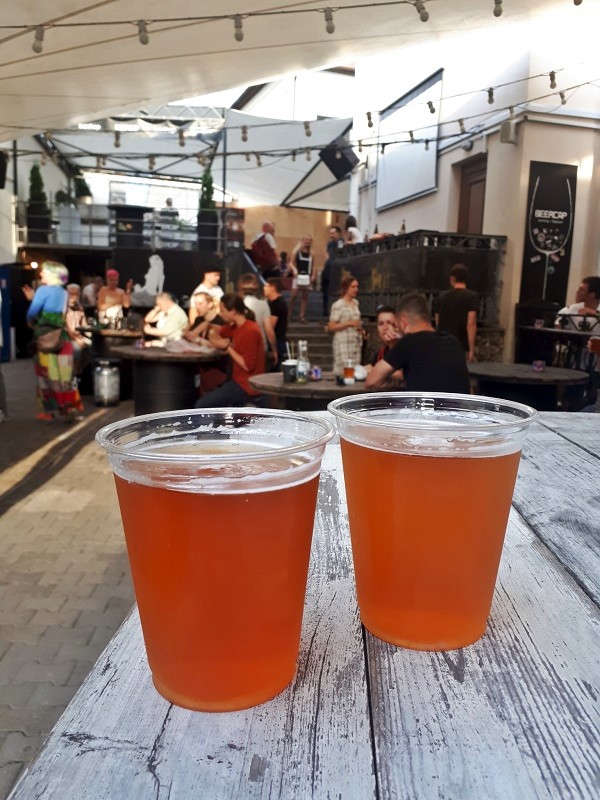
Sunset walk
As the sun began to set, I walked back along Prospekt Nezavisimosti towards my hotel.
The low sun cast beautiful colours across the classical-style Soviet buildings lining this grand boulevard.
Before reaching my hotel, I stopped by the local GUM, which stands for Gosudarstvennyj Universinyj Magazin, meaning State Department Store.
In Soviet times, the GUM was the main department store found in the biggest cities across the former Soviet Union, essentially functioning as a sort of communist shopping mall.
Of course, the biggest and most elaborate GUM was in Moscow, though cities like Kyiv and Minsk also had quite impressive stores.
Nowadays, most GUM stores are not dissimilar to regular shopping centres or department stores.
The Minsk GUM is a pretty cool place to explore, even if you don’t need to buy anything, as the high ceilings and chandeliers give it a much more classy feel than it actually is.
The GUM also houses a large, modern supermarket, which was handy for stocking up on water, beers, and chechil (smoked, braided, salty cheese strings, a popular beer snack in the Russian world) to eat and drink in the hotel.
After enjoying the beers in my hotel room, I called it a night, as there was more exploring planned for the next morning!
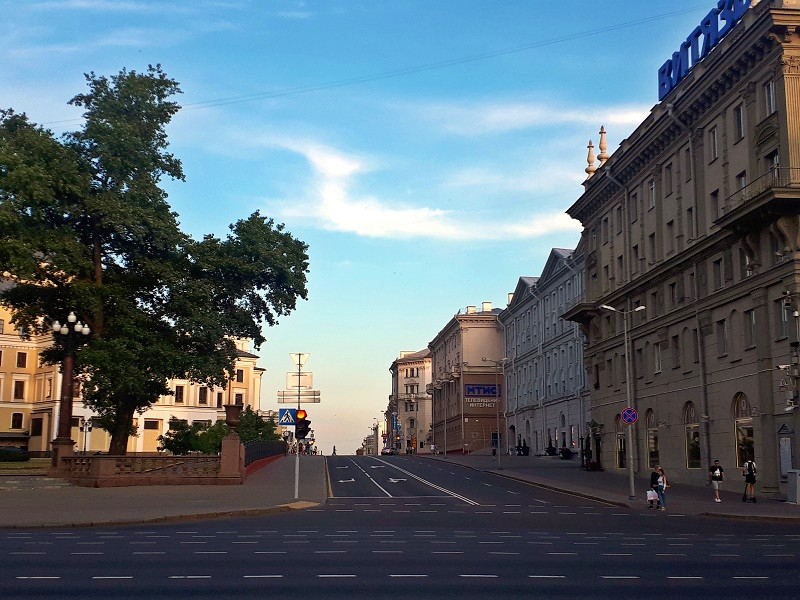
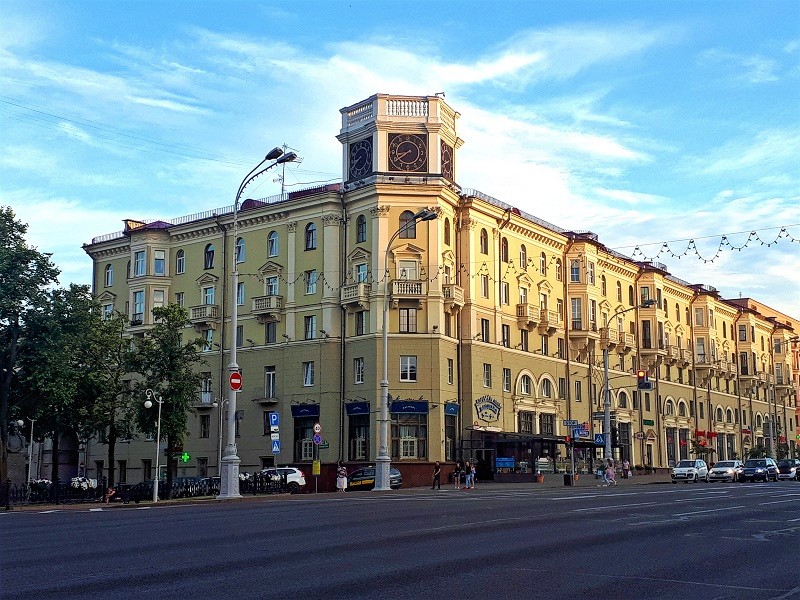
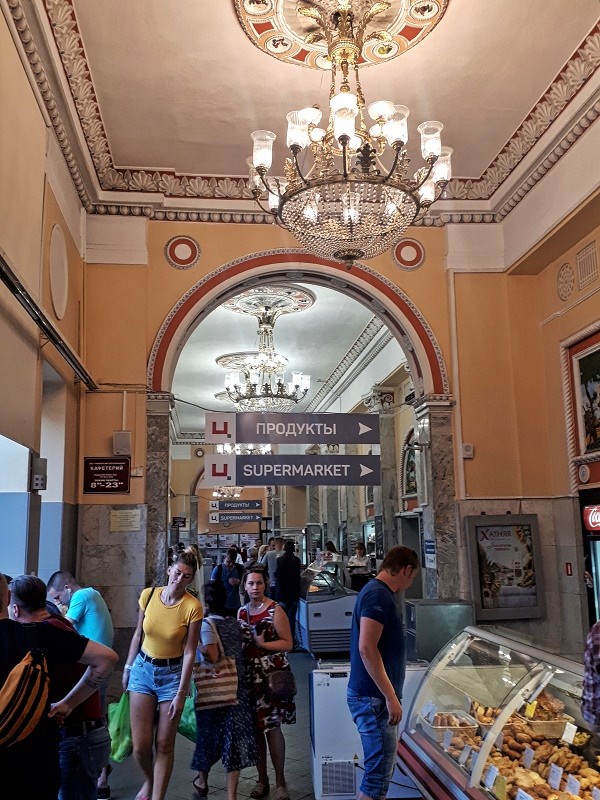
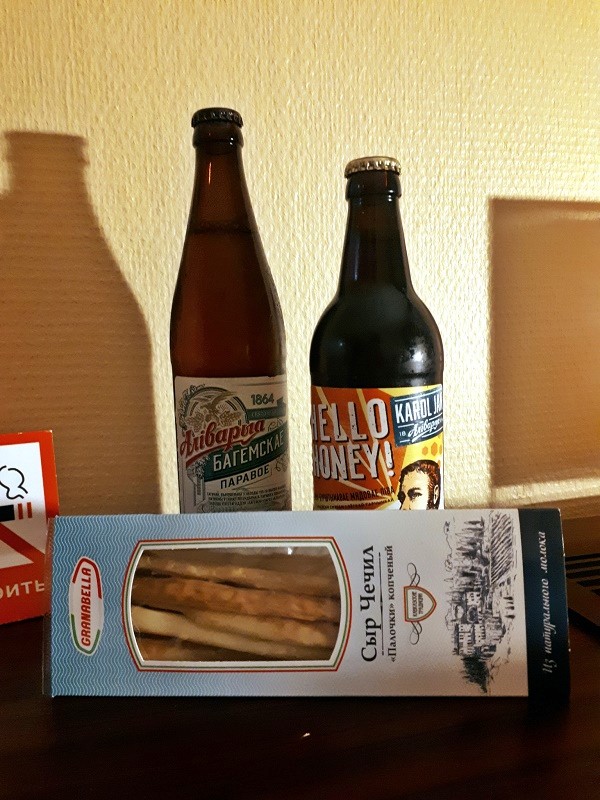
Victory Square
The next morning in Minsk began with a quick metro ride to Ploshchad Pobedy (Victory Square) to continue my visit of the city.
Ploshchad Pobedy is dominated by a massive 40-metre-tall obelisk, which serves as a memorial to those who fell during World War II.
Minsk was one of the 12 cities across the Soviet Union to be declared a Hero City, an honorary title awarded for the exceptional heroism of its people during World War II.
The letters on the rooftops around Victory Square read: “Heroic deed of the people is immortal”.
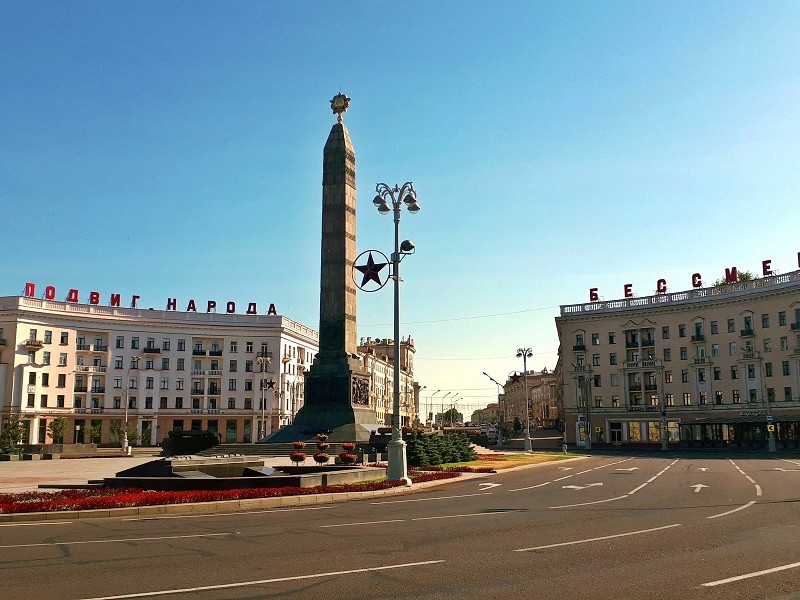
Breakfast
After my visit to Victory Square, I took a walk around Gorky Park, one of the nicest green spaces in the centre of Minsk, before heading back across the bridge over the river towards the city centre.
Just across from the State Circus, I stumbled upon an appealing café called Union Coffee, where I decided to sit down.
As I hadn’t managed to have breakfast yet, I decided to order the pancakes with blueberry sauce, which were delicious.
I also ordered a cappuccino and my favourite Borjomi mineral water from Georgia, which coincidentally was also Stalin’s drink of choice.
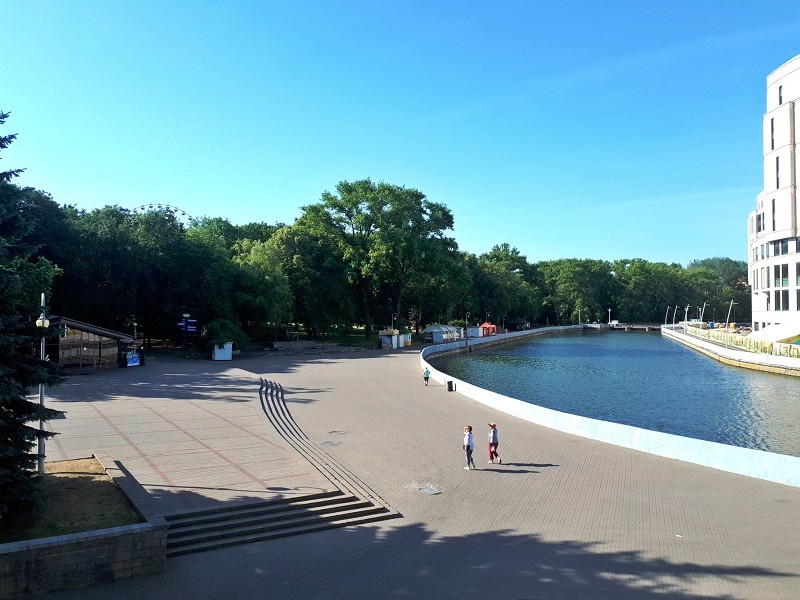
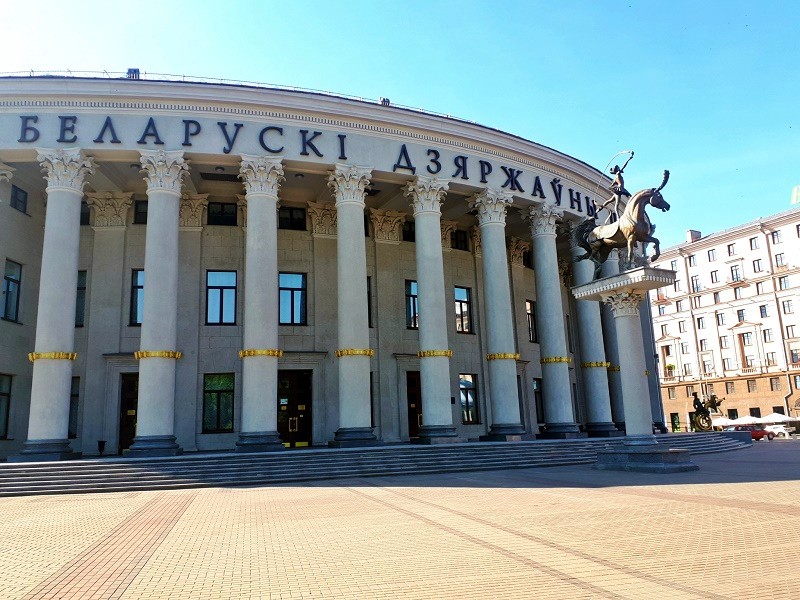
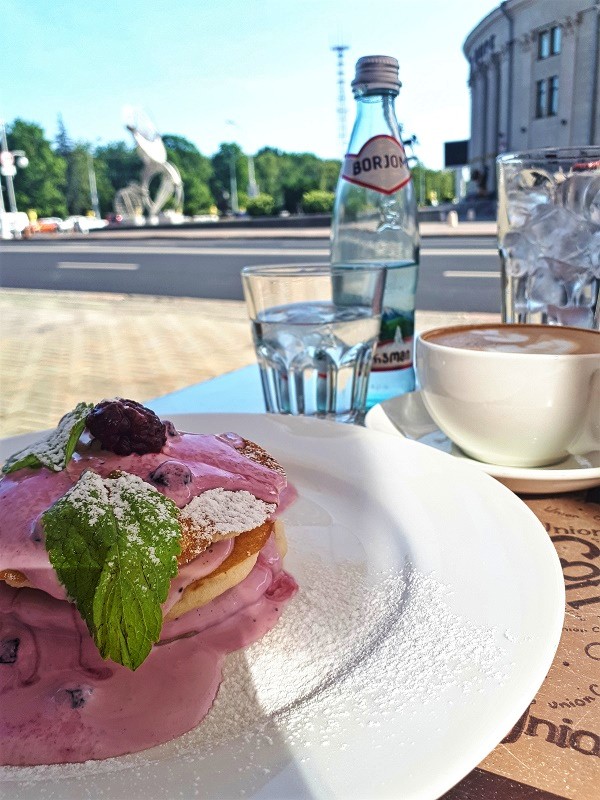
Retracing old steps
Back in the city centre, I retraced some of my steps from my first trip to Minsk in 2008, beginning with a visit to a tank monument near Alexander Square, which features a T-34 used by the Red Army to liberate the city in the summer of 1944.
I then continued towards the Presidential Administration of Belarus, where I almost got arrested on my first trip to Minsk when a soldier spotted me taking a picture of the building.
The soldier was clearly not happy with this and, after shouting at me, demanding to see all the pictures on my camera, and having the last few snaps deleted, he eventually relented and let me go.
This time around, it was much easier to take pictures of everything, including the Presidential Administration building, although it may have helped that I could take the snaps more covertly with my smartphone instead of the proper camera I took on my first trip, which clearly stood out more back in 2008.
That said, I still wasn’t sure of the current policy towards picture-taking in Belarus, so I erred on the side of caution and only took some quick (and sadly poor-quality) pictures at spots typically deemed important in dictatorial countries, including key infrastructure like the metro.
I admired some other Soviet-era government and public buildings, such as the Central House of Officers and the Palace of Culture of the Trade Unions, before concluding my visit to the city centre of Minsk.
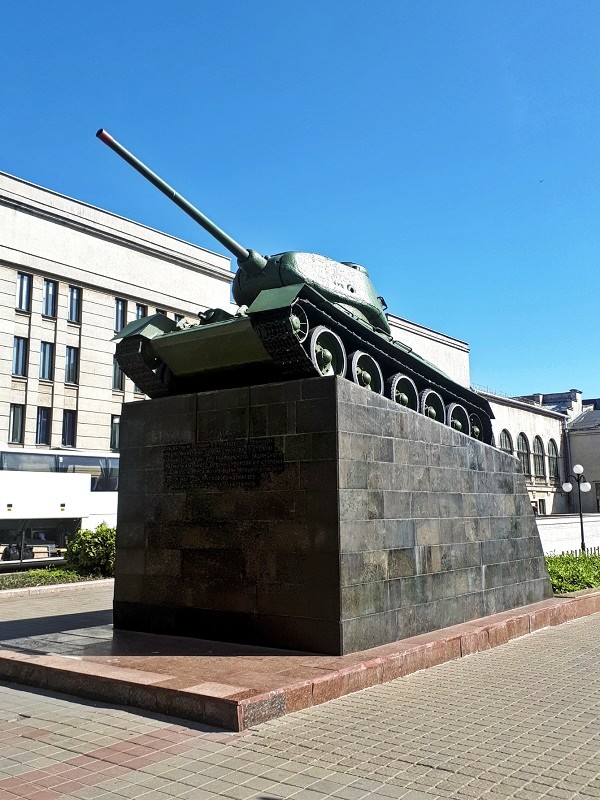
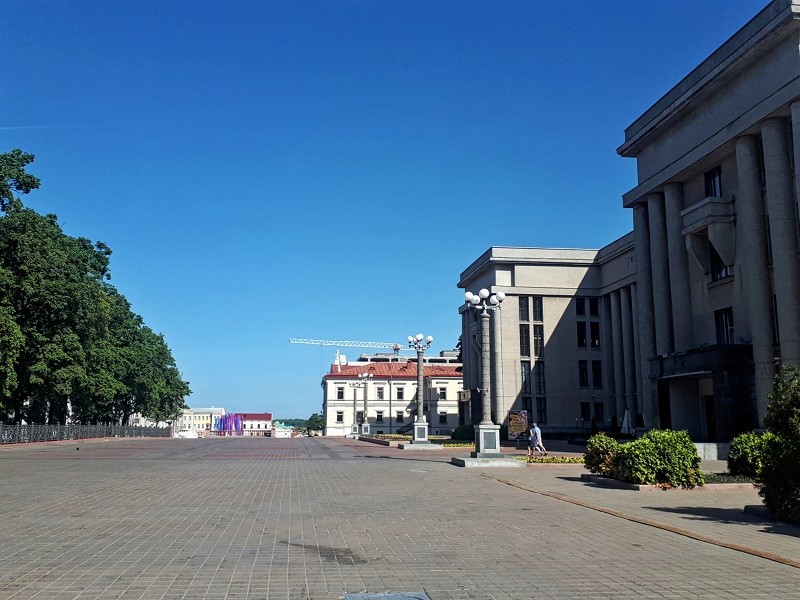
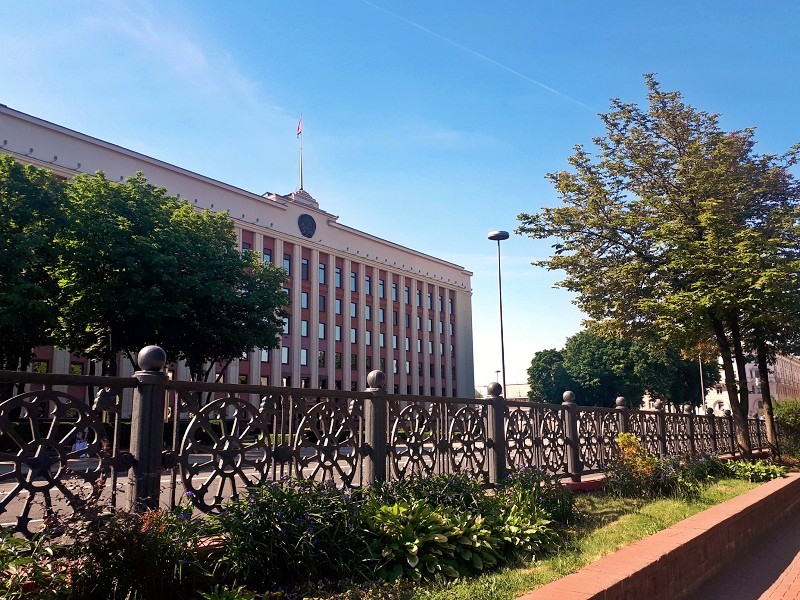
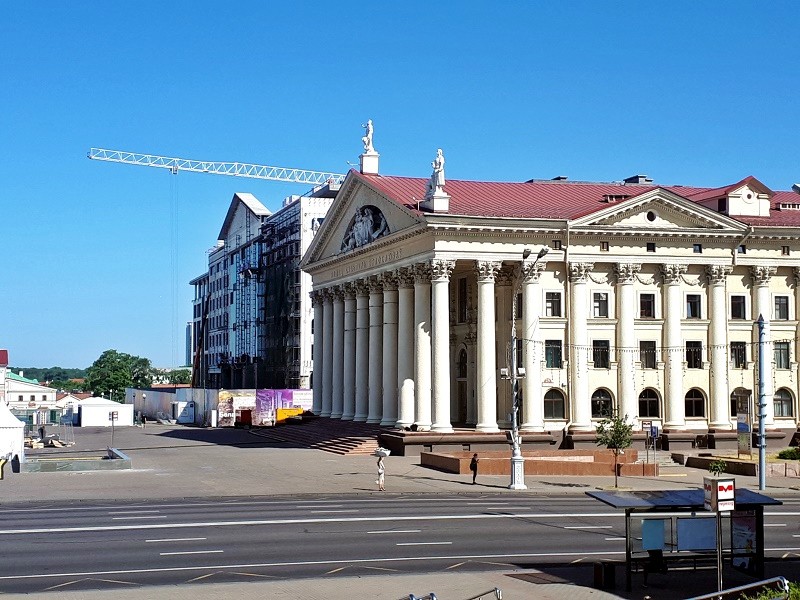
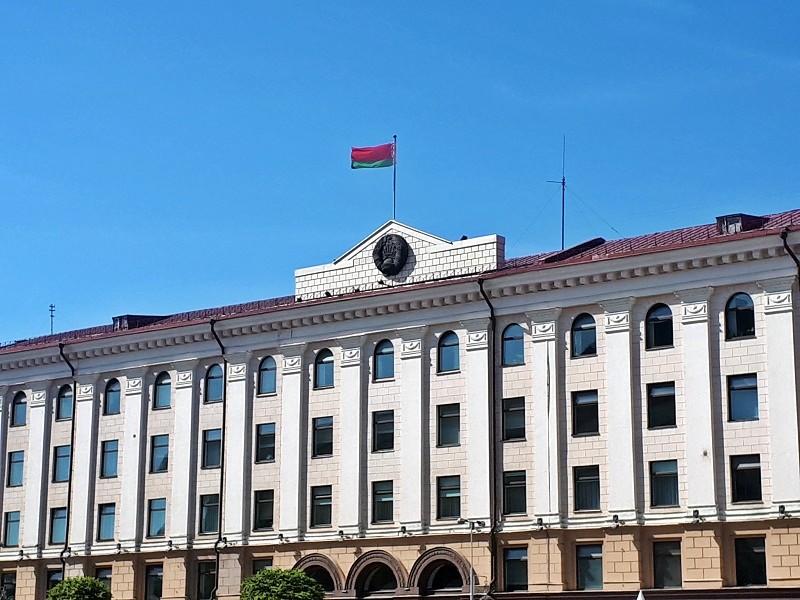
MZOR
Having completed my tour of the city centre, I headed down into the metro to take a train towards the MZOR (МЗОР) district of Minsk.
MZOR, which stands for Minskiy Zavod Oktyabr’skoy Revolyutsii (Minsk Factory of the October Revolution), is a district full of old state-owned factories and warehouses.
Although this industrial district thrived in communist times, many factories became abandoned when the Soviet Union collapsed, as they failed to remain profitable in the free market without state support.
In recent years, many of the old Soviet factories and warehouses in the MZOR quarter have been repurposed and turned into art galleries, cultural venues, or bars.
Indeed, walking through MZOR, you can sense the neighbourhood’s artsy vibe, with plenty of cool outdoor art installations and murals.
MZOR makes for a fun place to walk and a great stop for a drink if you’re looking to see something more quirky than the usual sights in the city centre of Minsk.
The MZOR district has undergone such renovation that even the statue of good old Lenin looks out of place among the modern artworks!
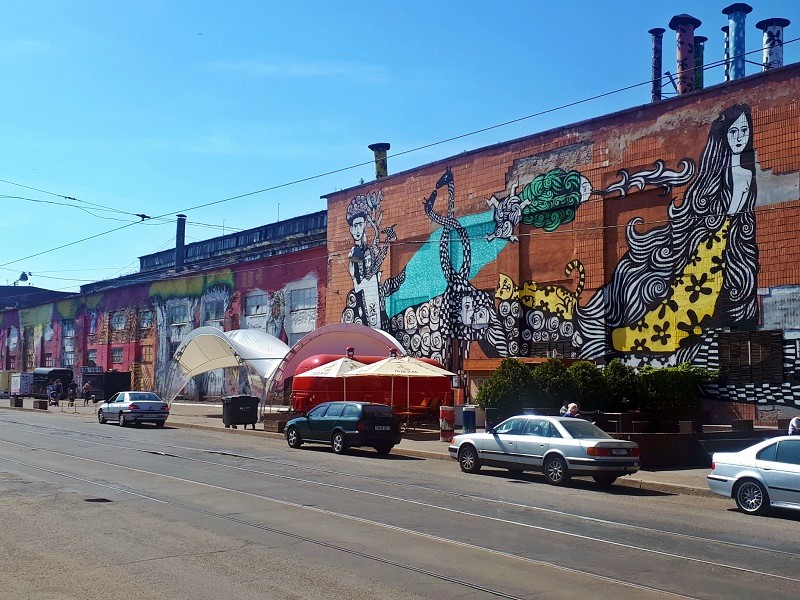
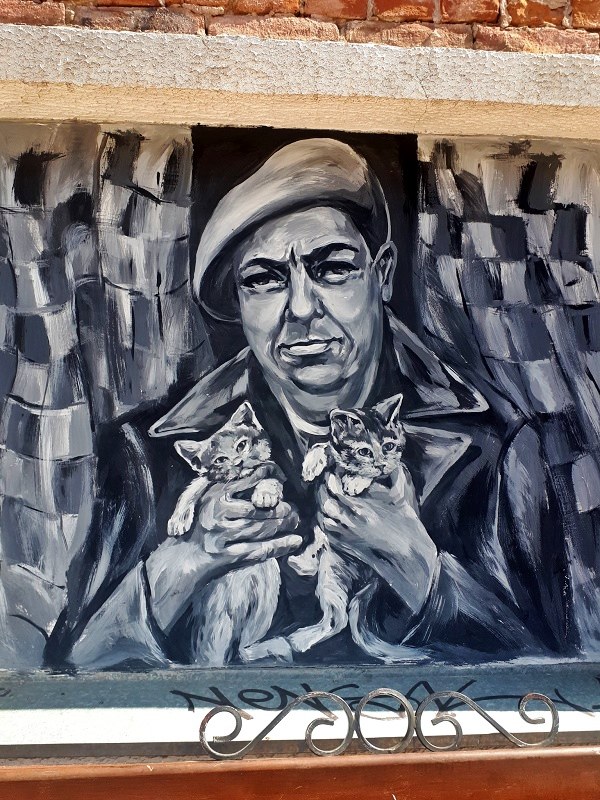
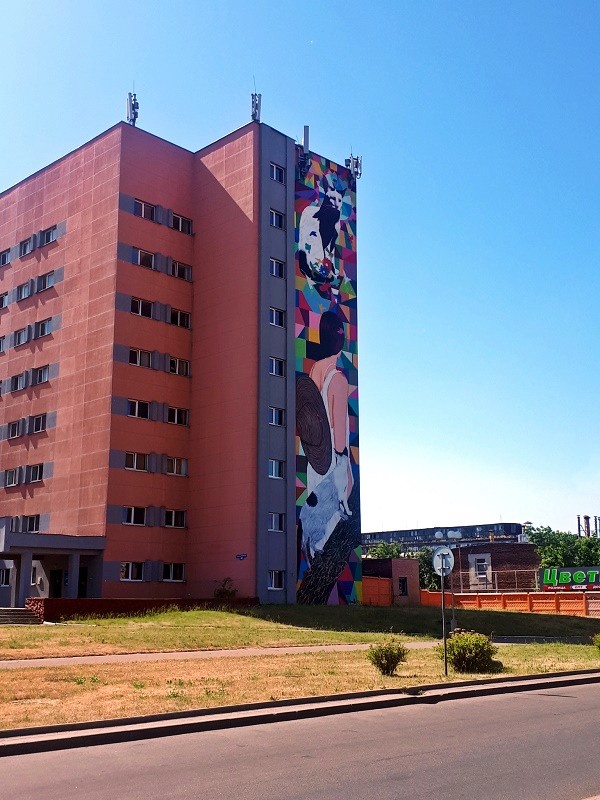
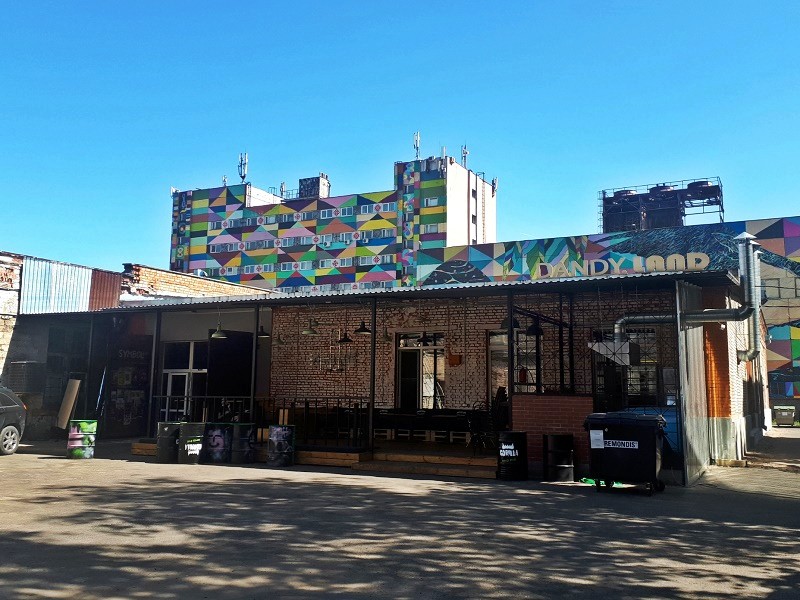
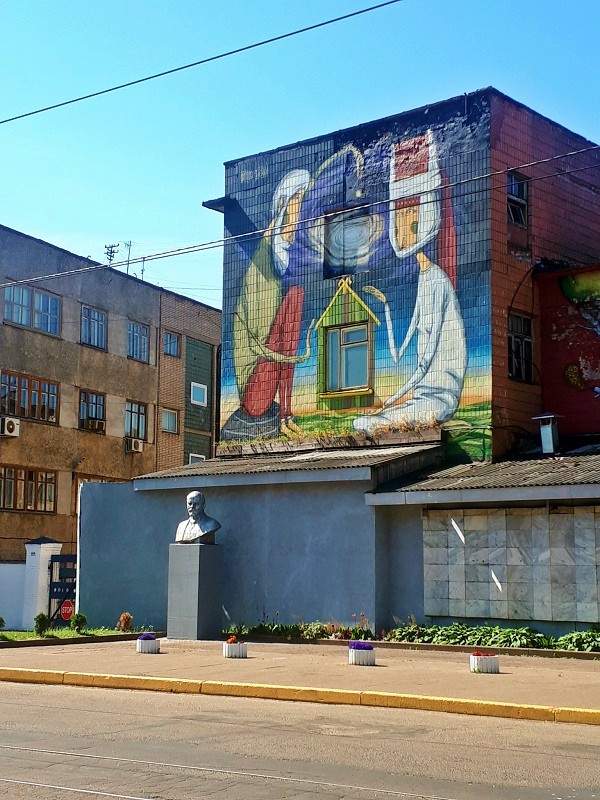
Back to the airport
After a drink at a bar in the MZOR district, it was time to head back into the metro and make my way to the central bus station, located next to the railway station, where I would take the bus back to Minsk Airport.
In front of the train station was one last sight of Minsk I had yet to visit.
Called the Gates of Minsk, these twin buildings were designed in Stalinist style to impress new arrivals to the city.
From the window of the airport bus, I watched the modern building of the National Library of Belarus and some colourful Soviet mosaics on suburban flats before the urban landscape of Minsk gave way to green fields, eventually leading to the sight of the airport terminal.
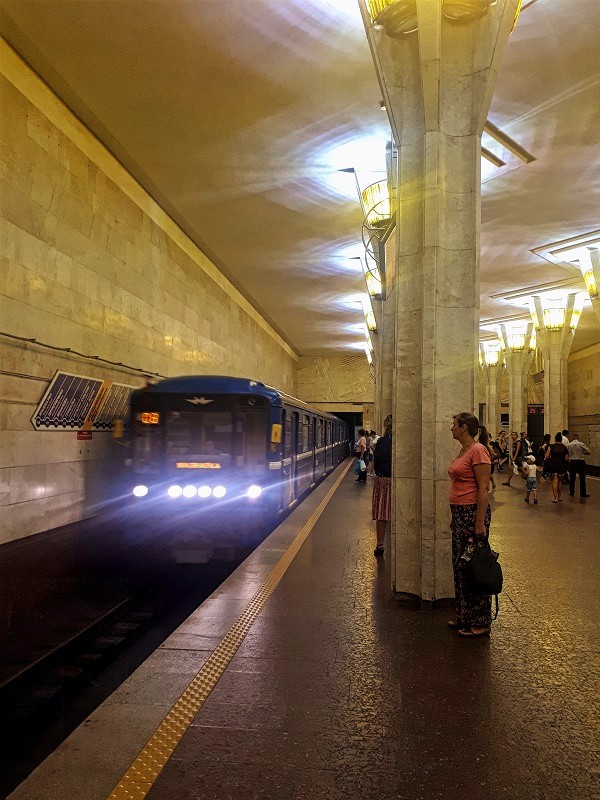
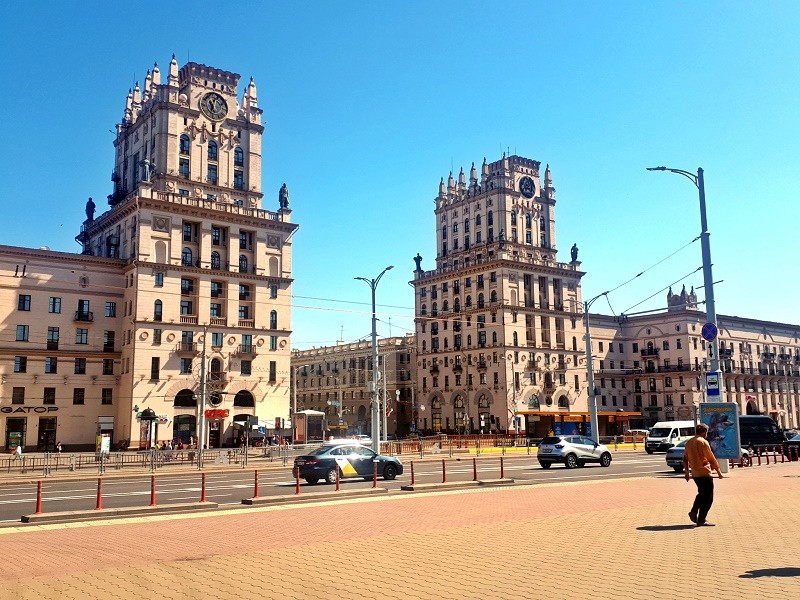
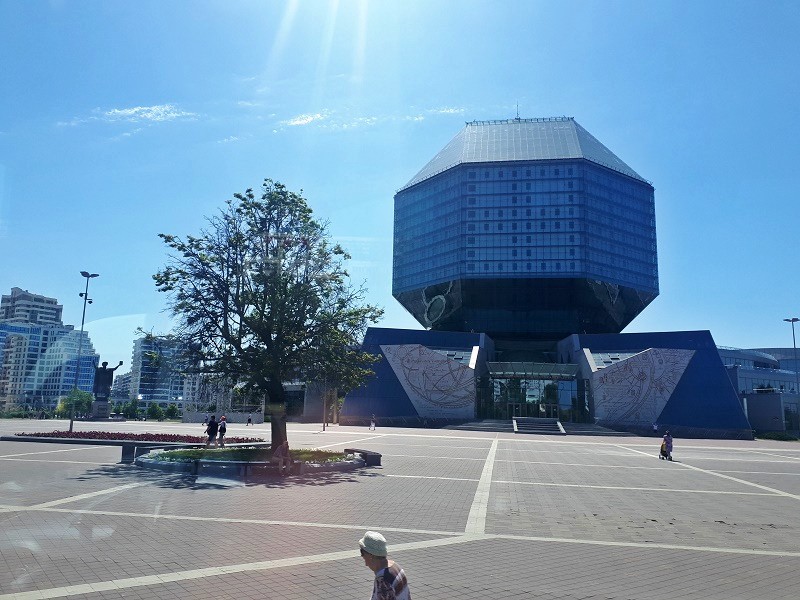
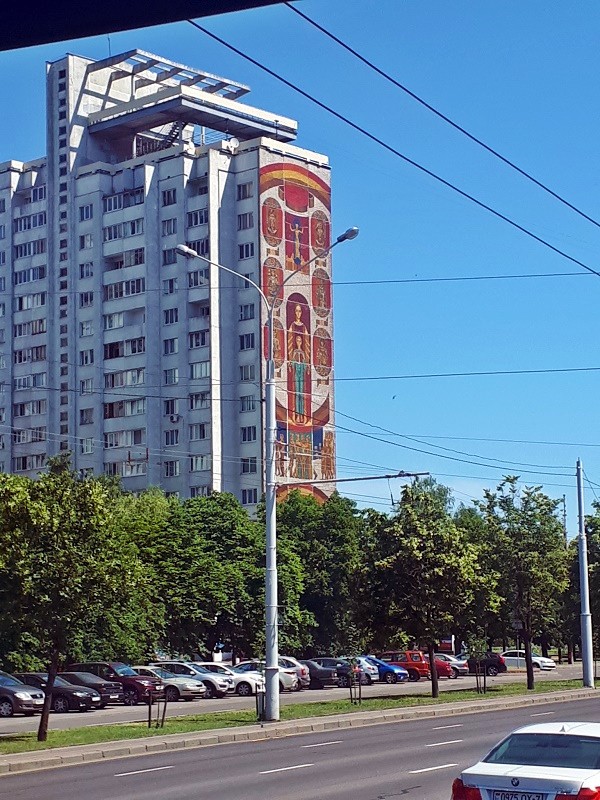

Conclusion
Minsk, the capital of Belarus, is a highly unusual but fun and interesting travel destination where you’re transported back to Soviet times.
The city centre of Minsk is filled with grand communist-era architecture, including magnificent Soviet murals, Lenin statues, World War II memorials, and impressive administrative buildings built in typical Stalinist style.
Minsk also boasts a vibrant social scene, with plenty of appealing cafés, bars, restaurants, and nightclubs.
There is a lot more to see and do in Minsk besides walking along the Soviet-era buildings in the centre, such as a visit to the MZOR district with its repurposed factories and warehouses, now home to cultural venues, art galleries, and bars.
Soviet ghosts are, however, not just a thing of the past in Minsk, as Belarus remains very much a dictatorship with no freedom of speech or association, nor fair elections.
Although I loved my trip to Minsk, travel to Belarus currently comes with a lot of security issues, especially for westerners, who face the risk of arbitrary arrest and being used as a bargaining chip by the Belarusian regime.
However, when the Lukashenko regime finally collapses and a more liberal – or at the very least, international law-abiding – administration takes its place, Minsk will certainly make for a super intriguing travel destination again.
Trip report index
This article is part of the ‘Back to Central Asia: Travels Through Kazakhstan and Kyrgyzstan‘ trip report, which consists of the following chapters:
1. Review: TAROM Domestic Flight Bucharest to Cluj-Napoca
2. Cluj-Napoca: A Travel Guide to Transylvania’s Vibrant Capital
3. Turda Salt Mine and Gorge: An Easy Cluj-Napoca Day Trip
4. Cheile Turzii: Hiking Through the Impressive Turda Gorge
5. Review: Cluj-Napoca Airport Business Lounge
6. Guide: Free Turkish Airlines Transit Hotel at Istanbul Airport
7. Minsk, Belarus: Chasing Soviet Ghosts in Europe’s Last Dictatorship (current chapter)
8. Review: Turkish Airlines Business Class Minsk-Istanbul-Almaty
9. A Visit to Almaty, Kazakhstan’s Vibrant Economic Capital
** rest of the chapters to follow soon **

